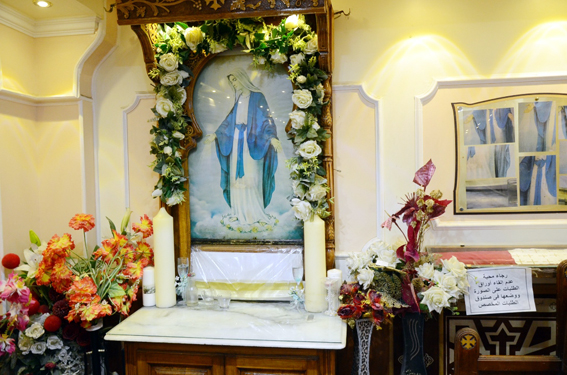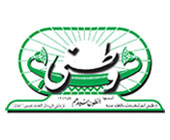Given that Watani International has in 2021 marked 20 years in print—our first issue was printed on 18 February 2001—we promised our readers to regularly publish reviews of our issues during those 20 years. The reviews read like history in real time. We already reviewed the issues from 2001 to 2014; today we keep good on our promise by covering the years 2015, 2016, and 2017. Those years saw Egypt set out to rebuild what had been lost or damaged during the years of the “Arab Spring” from 2011 to 2013 when an Islamist ruling regime devastated Egypt on all fronts: the cultural, political, economic, security, sectarian; and attempted to wipe out Egypt’s identity by instating Islamism. In July 2013, the Islamist regime was overthrown by the massive 30 June 2013 Revolution which Egypt’s military stepped in to support, and the country embarked on a path of healing, rebuilding, and founding a civil, secular State. A new Constitution was established in 2014, and a new president—Abdel-Fattah al-Sisi—was elected.
Resounding Islamist failure
During the years 2015, 2016, and 2017 Watani International had increasingly gone online as en.wataninet.com; also on Facebook, Twitter, and our mobile application. Given that all the articles or episodes printed during these years are already posted online, I will only cite the most significant; the reader is invited to visit our website for details.
On the political level, the most prominent event in 2015 was the election of a new parliament which included quotas for women, Christians, the disabled, and youth. The quotas were a one-time affirmative action that would not recur in the future. According to independent monitors, the elections involved no major violations, no vote rigging, no security interference, and no sectarianism. The results were a resounding failure for the Islamist current, and an unprecedented success for Copts.
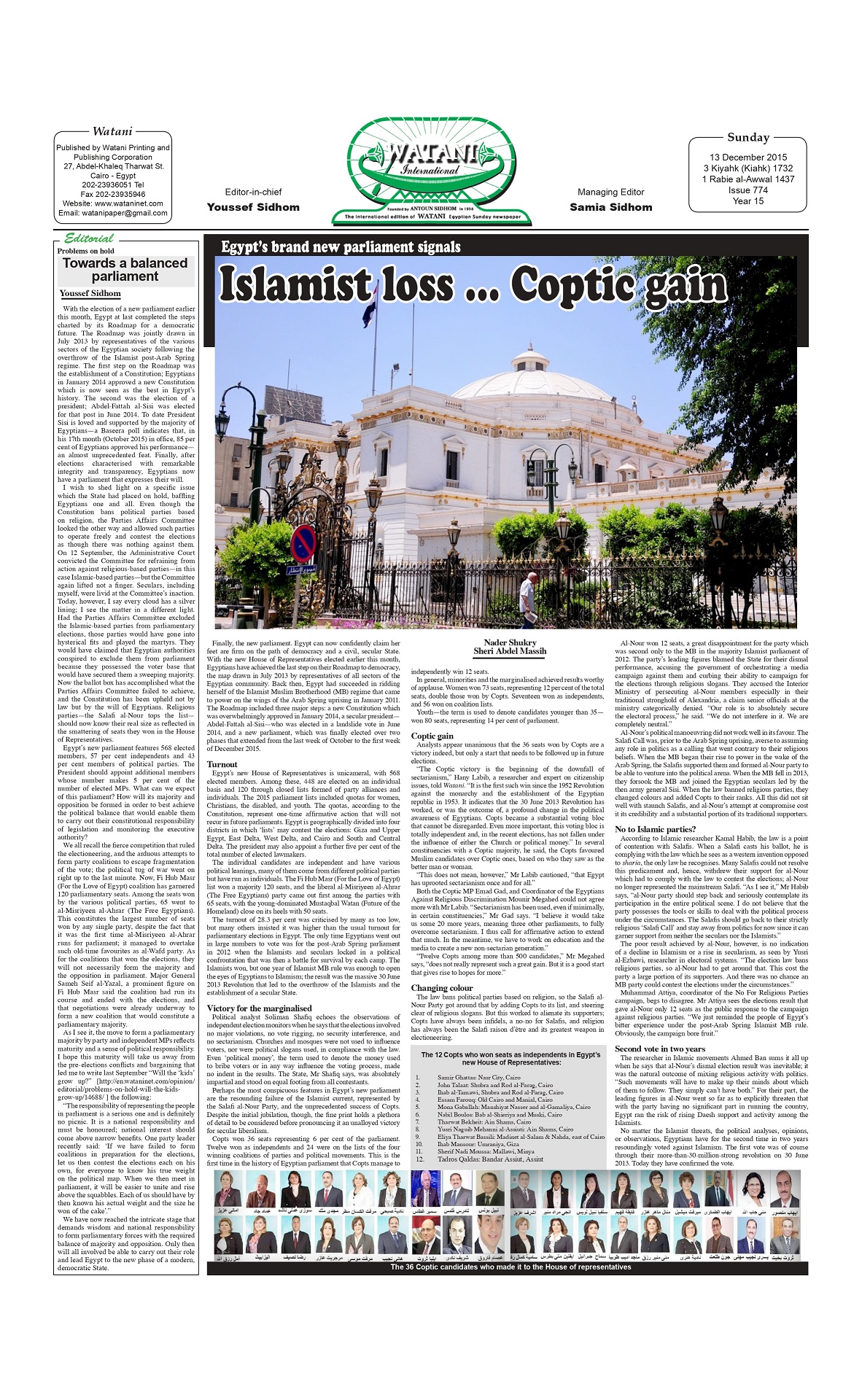
New Suez Canal, Pound floated
It was imperative for Egypt to rebuild its economy which had been left in tatters following the Arab Spring. Watani International reported extensively on efforts on that front.
August 2015 witnessed inauguration of the New Suez Canal, a new 72-kilometre canal branching from the original course and running parallel to it till it rejoins it. The new canal aimed at speeding up transit time and allowing ships to sail in two-way directions at the same time. Our paper printed and posted feature stories on the new and original canals, the history of the Suez Canal, and the royal yacht al-Mahroussa that featured in the original opening in 1869 and in the 2015 opening.
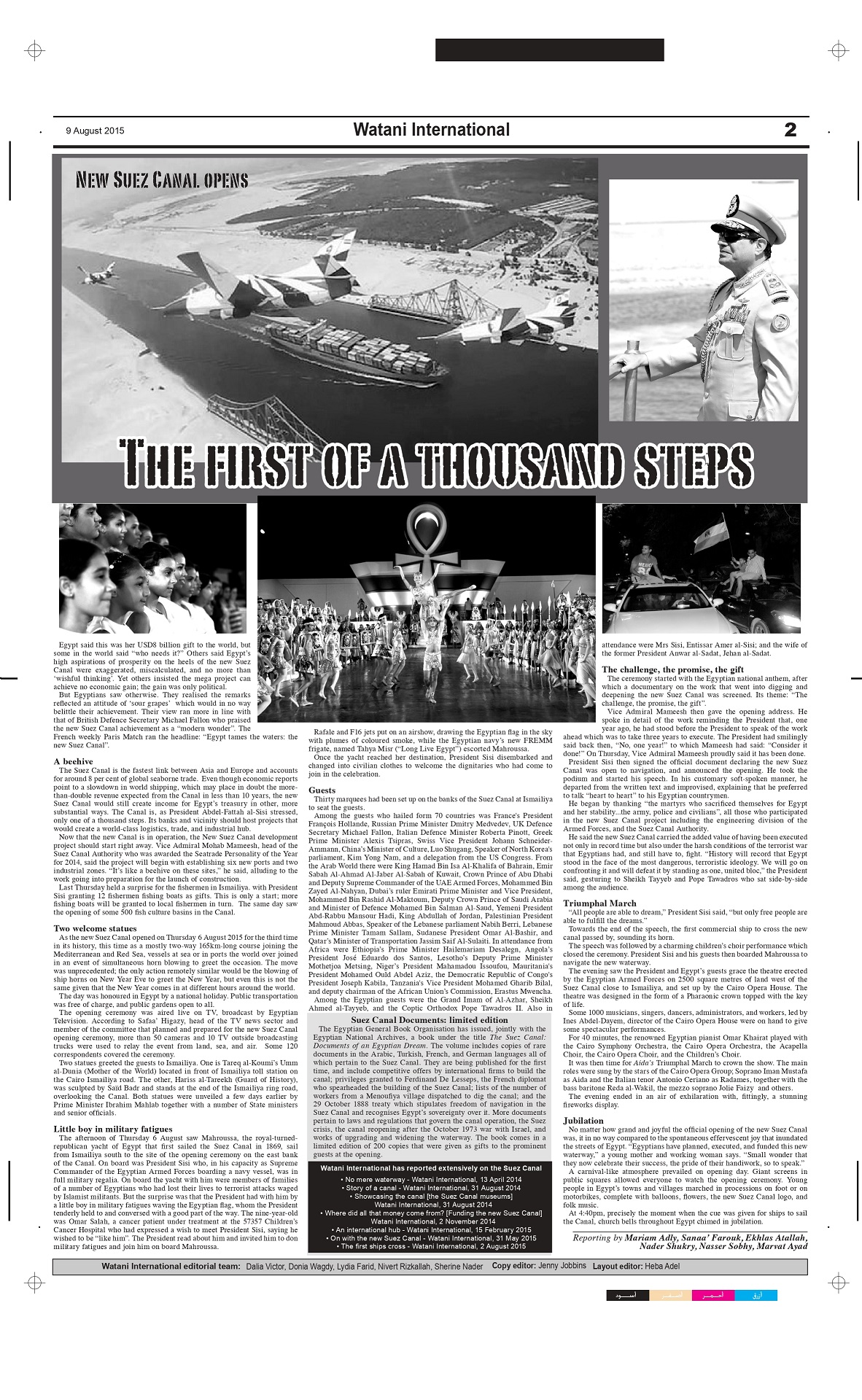
In October 2016, news of a 500 billion cubic feet natural gas field discovered by Royal Dutch Shell gave rise to hopes the economy would spring back to life, especially that it followed a much bigger find by the Italian ENI, which amounted to 30 trillion cubic feet.
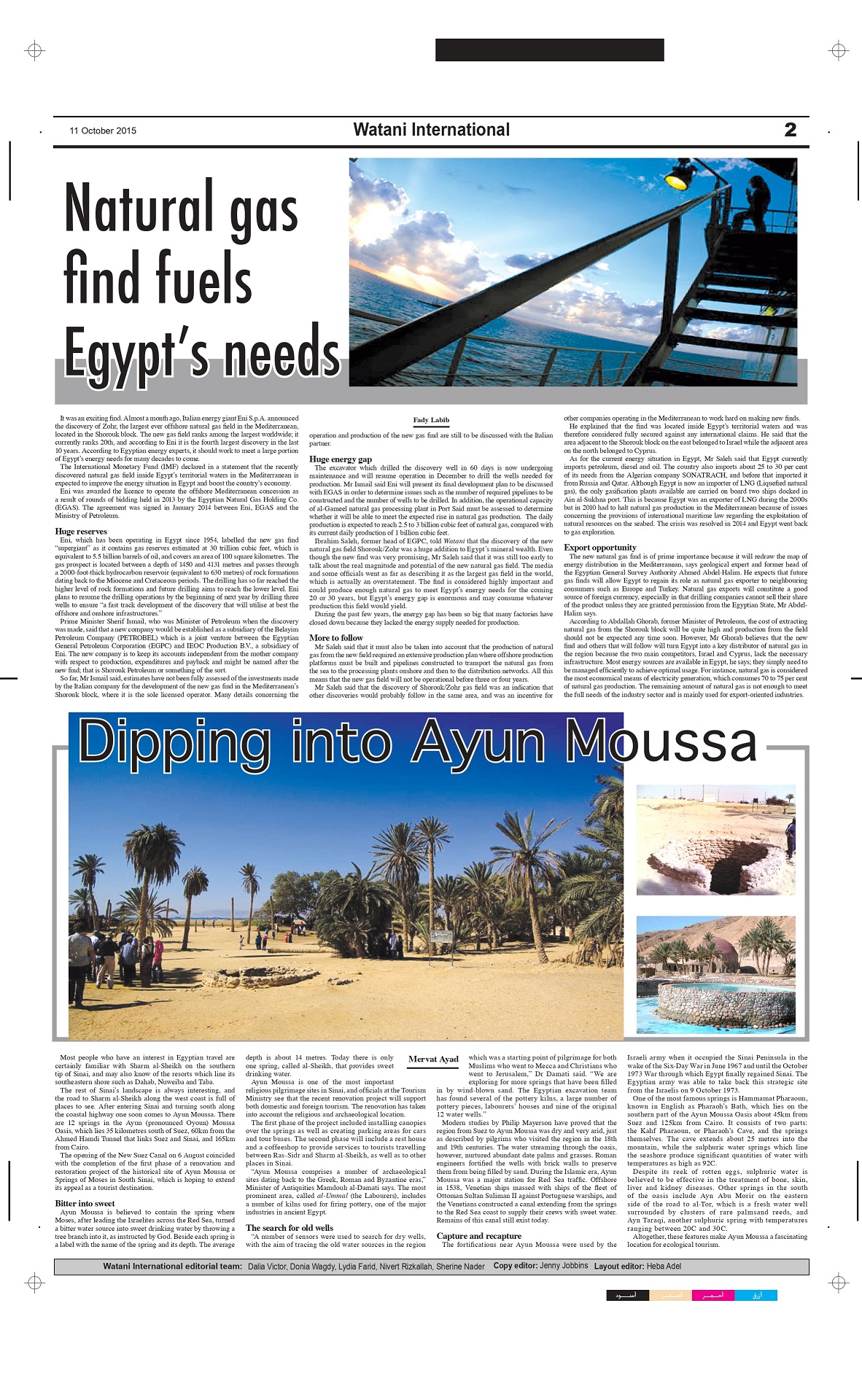
In November 2016 the Central Bank of Egypt floated the Egyptian Pound. The decision was to have far reaching repercussions that were altogether beneficial for the economy, but acted as a bitter, bitter medicine Egyptians had to swallow.
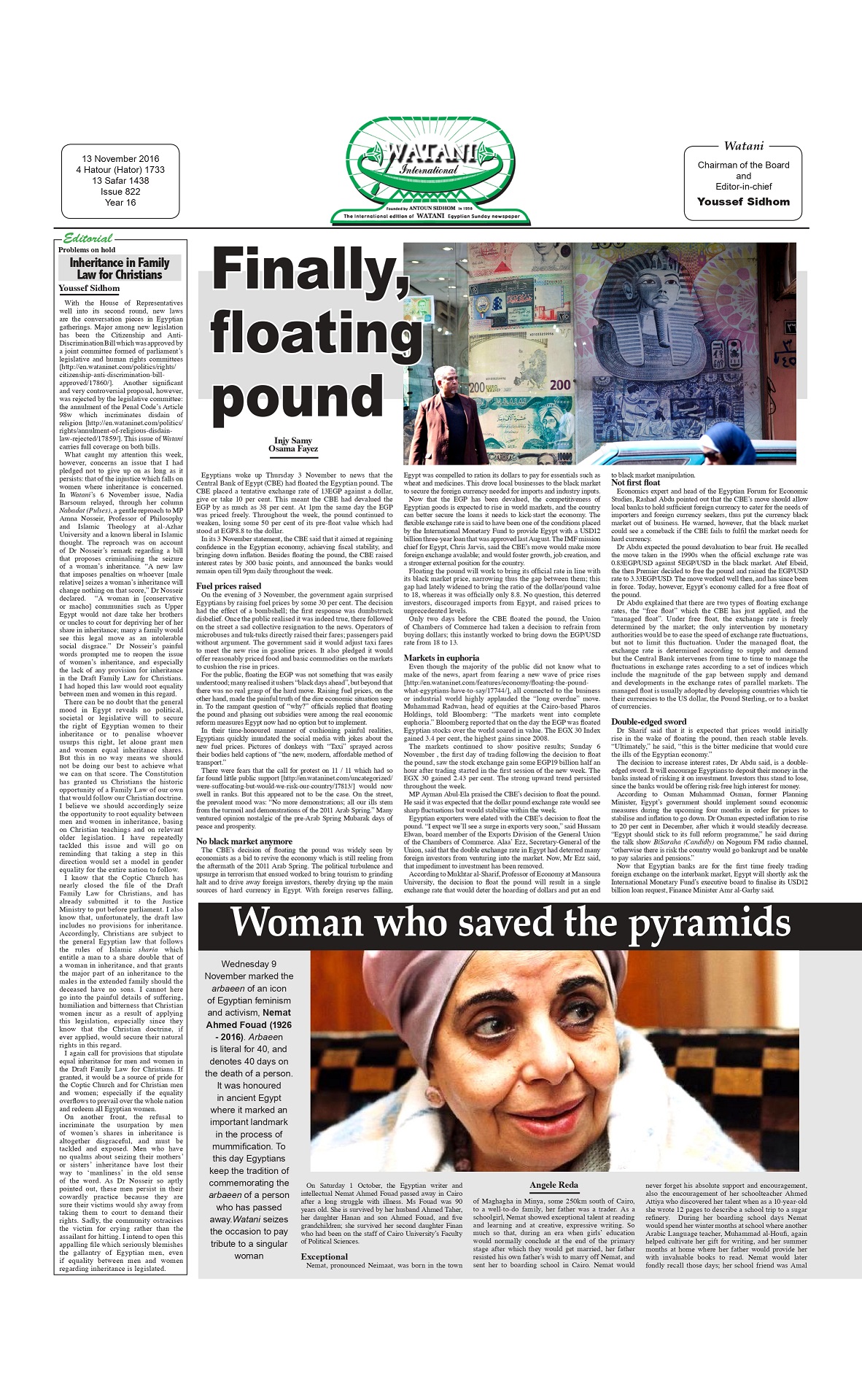
November 2016 saw the first National Youth Conference convene in the Red Sea resort of Sharm Al-Sheikh. It has since become a successful annual event that spearheaded a number of national projects including the mega project Decent Life which works on the holistic development of Egypt’s villages. It also spearheaded another annual event in Sharm Al-Sheikh: the World Youth Forum.
First ever law for building churches
September 2016 saw Parliament pass the long-awaited Law for Building and Restoring Churches, the first ever in Egypt to govern that issue. Until then, it was next to impossible for Copts to obtain official licence to build or restore a church. Copts, who direly needed churches in view of the growing congregation and declining conditions of existing churches, resorted to circumventing the law and building churches without licence. The 2016 law stipulated a straightforward, time limited legal procedure for obtaining licence to build or restore a church or affiliated building, and included provisions for legalising already existing unlicensed ones.
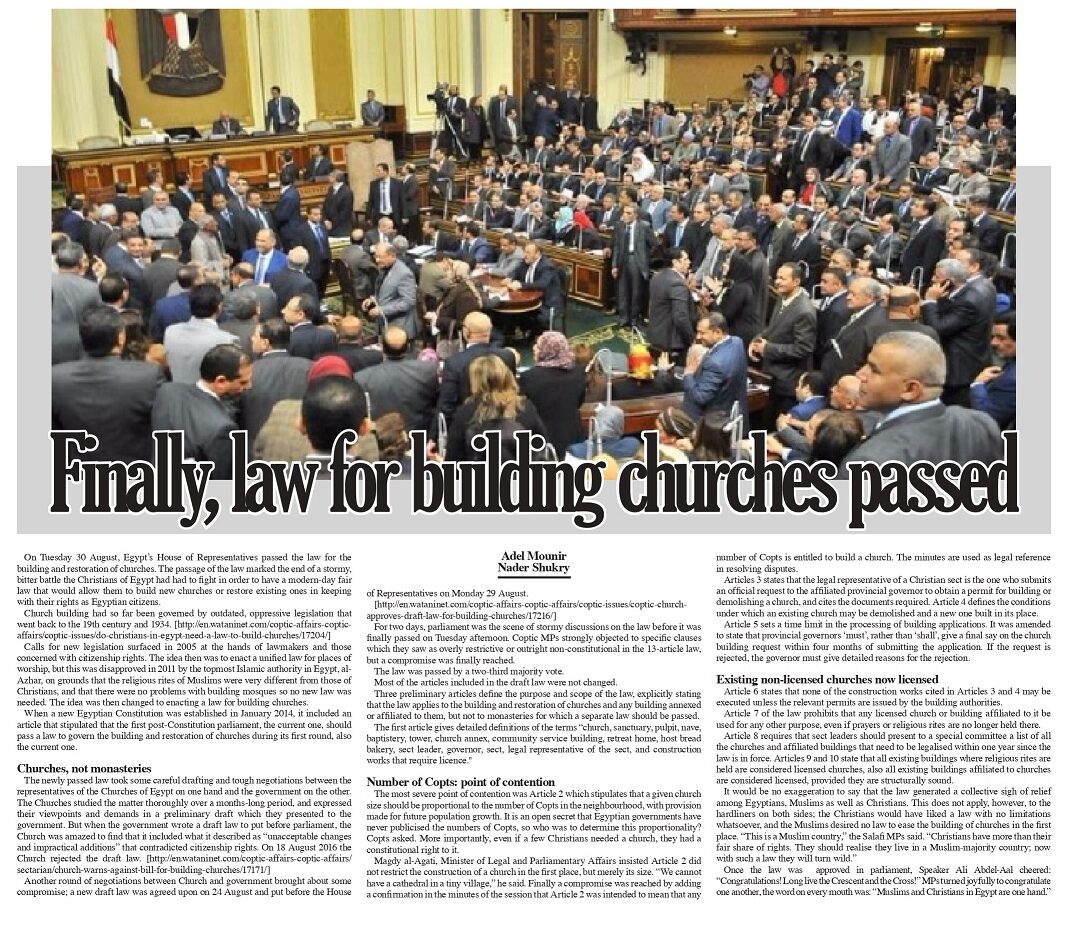
A few weeks before passing the law, Watani International had published a report titled “Do Christians in Egypt need a law to build churches?” that explored the history of the church building dilemma in Egypt up to modern times.
But it was not all smooth sailing for Egypt.
Terrorist and sectarian incidents persisted. The MB had threatened that Ramadan in 2015 would be a bloody month for Egyptians; their threat materialised into a number of bombings inside Egypt and attacks against the military in Sinai. Among the most painful for Egyptians was the assassination of Prosecutor-General Hisham Barakat in July 2015.
Libya’s Coptic Martyrs
For Copts, 2015 started on a gruesome note with video footage aired of 20 Coptic migrant workers and one Ghanaian in Libya lined up on a beach in Sirte and beheaded for their faith by Daesh (also known as Islamic State, IS). They came to be known as the Libya martyrs; the Coptic Church declared them martyrs of faith, a church was built on order of President Abdel-Fattah al-Sisi in their honour in al-Our, the home village of 13 of them and, in June 2017 the Coptic Church decided to designate 15 February—the date the beheading was made public—an annual feast to celebrate modern-day martyrs; the first feast was celebrated in 2018. Watani International reported extensively on the incident, the lead-up to it, the martyrs and their bereaved families, and the al-Our church.
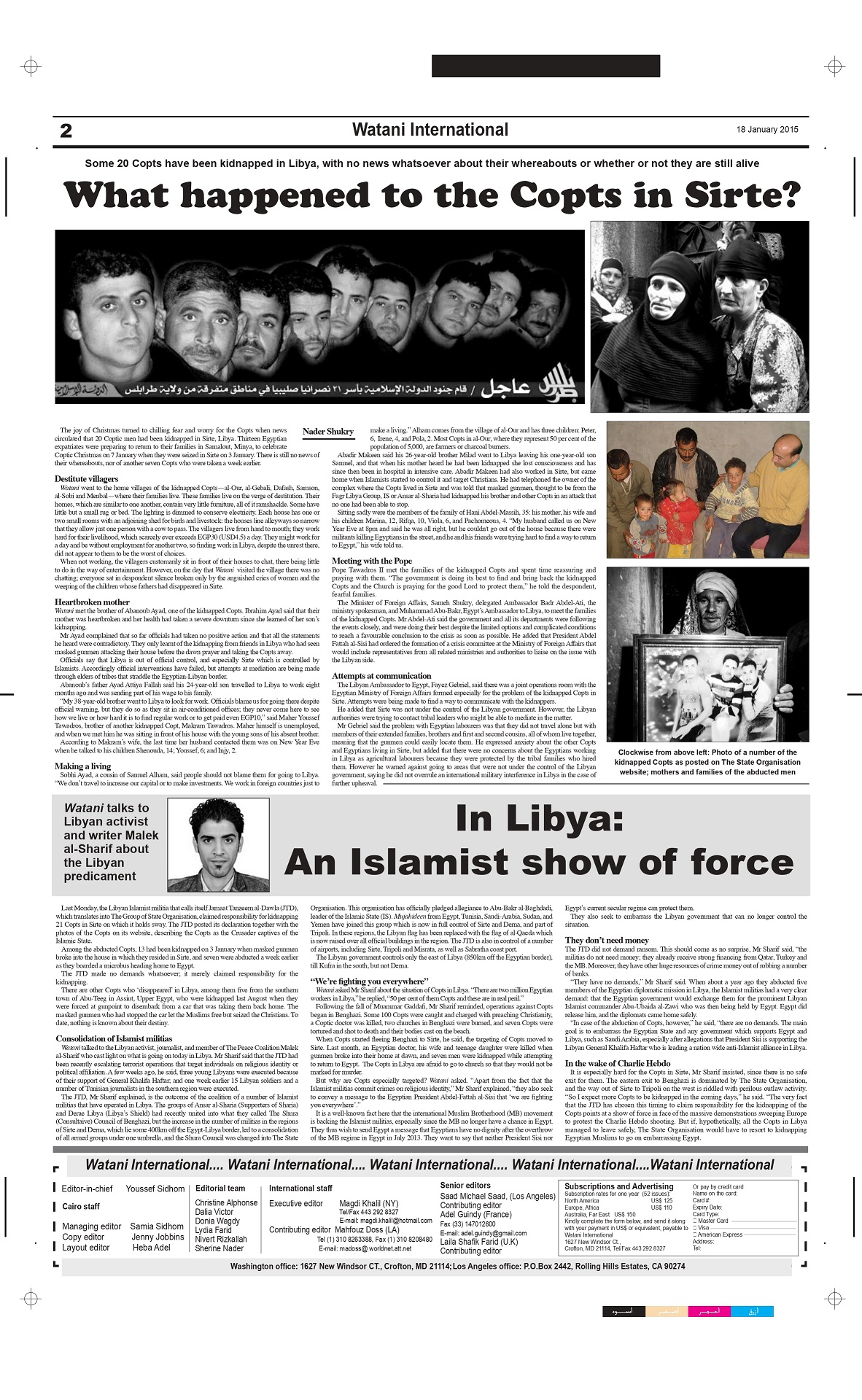
Egypt’s Copts continued to suffer at the hands of fundamentalist Muslims. Especially in villages, they were attacked under the by now usual pretexts that range from personal disputes to praying in unlicensed churches. In a number of cases such as in Kafr Darwish, Beni Sweif, in May 2015; and in Amriya, Alexandria, in October 2015, entire extended families were evicted from their home villages.
Lady of al-Karm
In May 2016, one of the most notorious attacks against Copts took place in the Minya village of al-Karm. On a rumour that a Coptic man was having an affair with a Muslim woman, his 68-year-old mother Suad Thabet was dragged from her home into the street, stripped naked and beaten up by three Muslim men while a Muslim mob looked on. The Coptic man had fled the village. Six Coptic homes—homes in rural Egypt are large and house extended families—were burned, and a Copt-owned plastics warehouse. Some 22 Muslim villagers were caught by the police and prosecuted, they were not convicted because the Coptic witnesses went back on their testimonies and preferred to ‘reconcile’ with the attackers. The case is still in court.
With some 65 per cent of the attacks against Copts taking place in Minya some 250km south of Cairo, Watani International republished a study on the topic; it was aptly titled “Why Minya?”
Watani International reported on several incidents where individual Copts were accused of contempt of Islam, an obscure charge unjustly used to penalise Copts and, not infrequently, free-thinking Muslims. Watani termed it the “Sword of Damocles”.
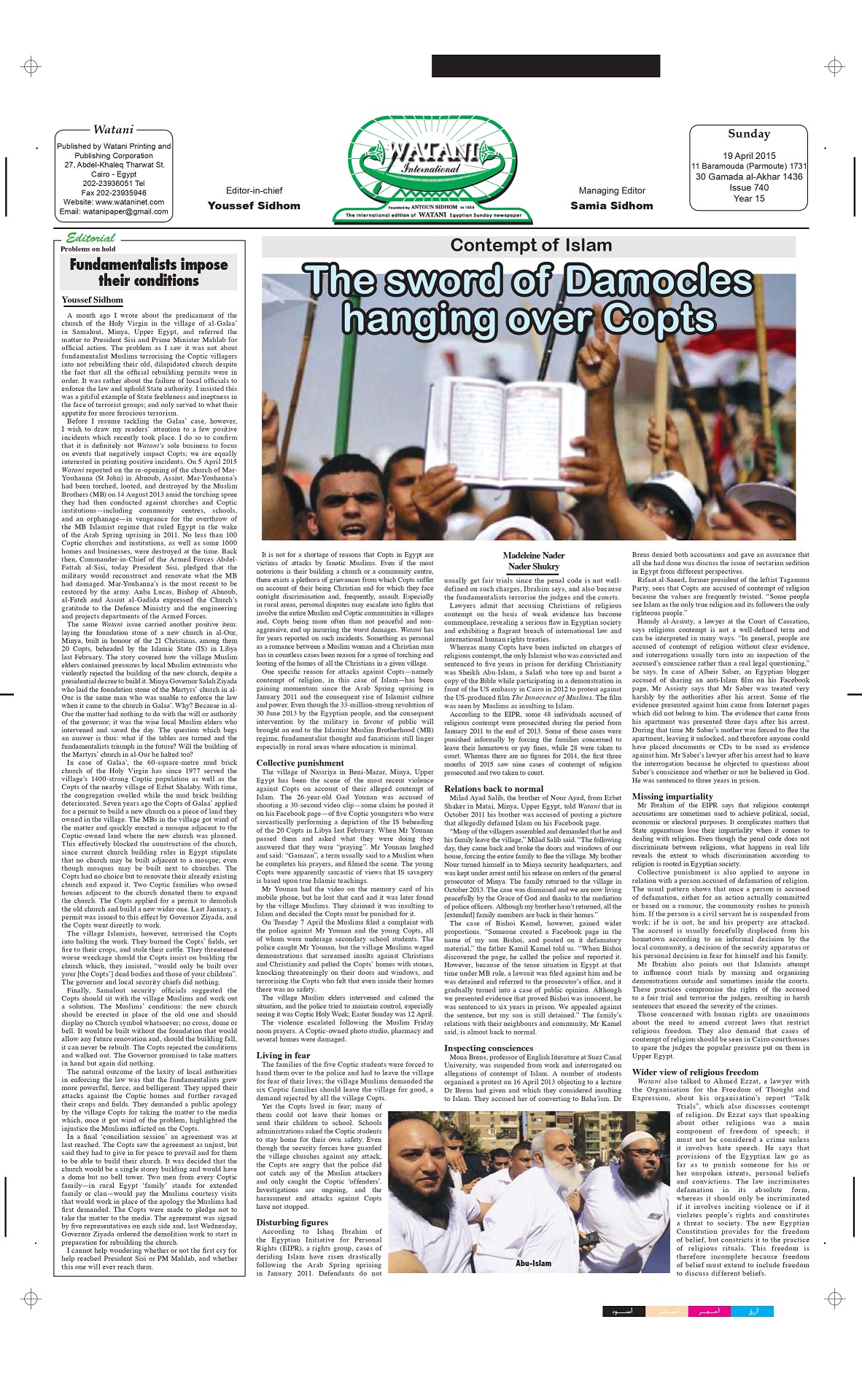
Suicide bombings at churches
The year 2016 ended tragically with a suicide bombing at Boutrossiya Church (church of St Peter and St Paul) in Cairo claiming the lives of 27 Copts and injuring 49 as they attended Mass on Sunday 11 December. The church was left severely damaged and bloodstained.

The incident broke the heart of Egypt in its entirety. By New Year Eve 2017, though, the Egyptian Armed Forces had fully repaired and restored the church—not its icons, however—while retaining the blood stains on a marble pillar and floor spot for remembrance.
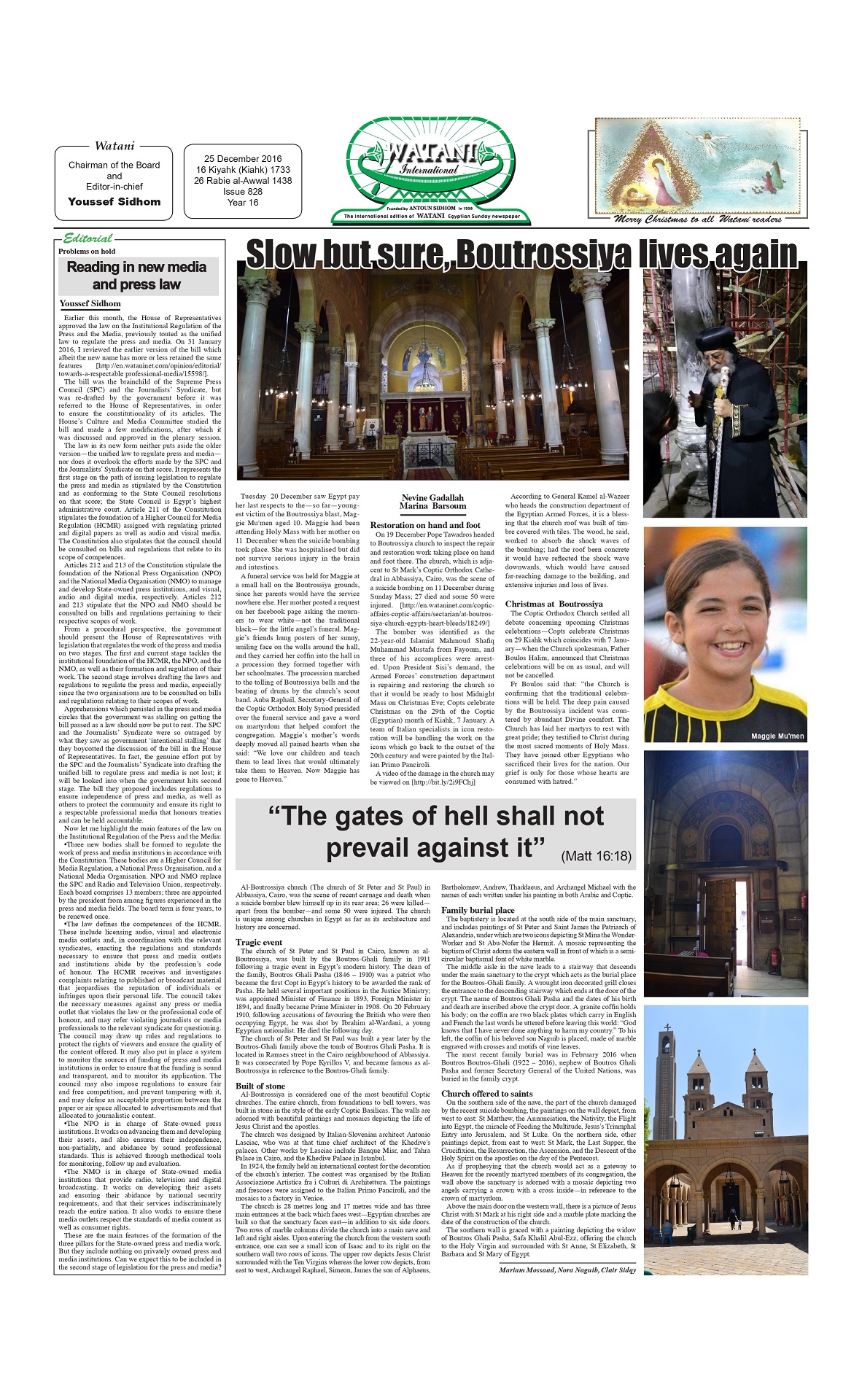
It was not the first time the Armed Forces rose to the task of repairing churches ruined by Islamists. It fulfilled a pledge made by President Sisi in January 2016 to repair or rebuild some 84 churches nationwide destroyed by the Islamist Muslim Brothers in a synchronised attack on 14 August 2014. The President told the Copts: “It’s no favour. We owe you this.” The task was completed by January 2017.
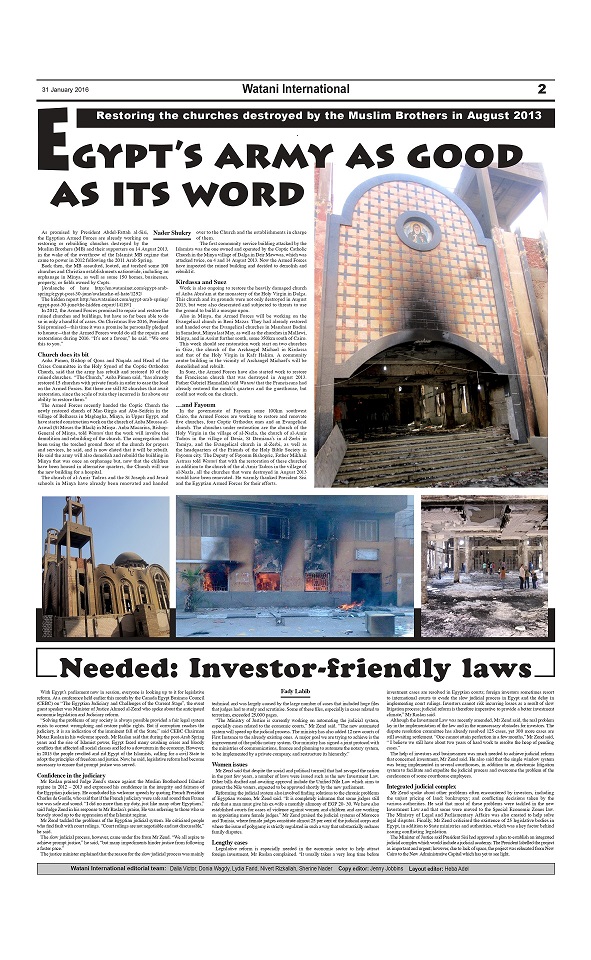
Two other suicide bombings took place on Palm Sunday 9 April 2017: one at Mar-Girgis Church in Tanta in the mid-Delta, and the other at St Mark’s Cathedral in Alexandria. The two bombings killed 49 persons, among them seven Muslim policemen and policewomen.
The Mediterranean town of Al-Arish near Egypt’s northeastern border was the scene of the killing of six Copts in the space of three weeks in February 2017 at the hands of jihadi Islamists in Sinai who threatened to kill any Copt who remains in town. Arish Copts fled for their lives, and repatriated elsewhere in Egypt with aid from the government and the Church.
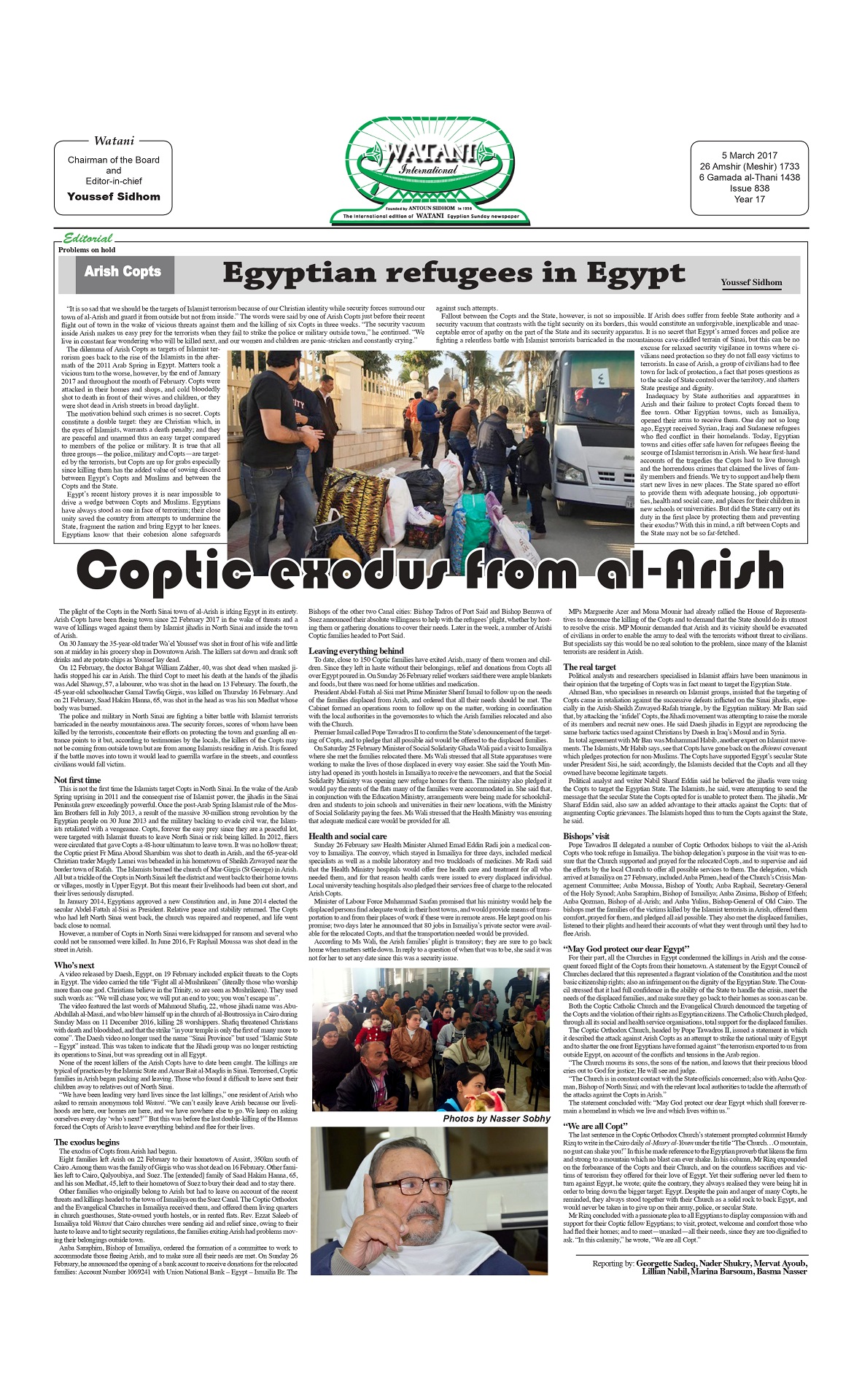
On 26 May 2017, 28 Copts including women and children were killed by Islamic terrorists while on their way for pilgrimage to the monastery of St Samuel the Confessor in the Western Desert in Minya.
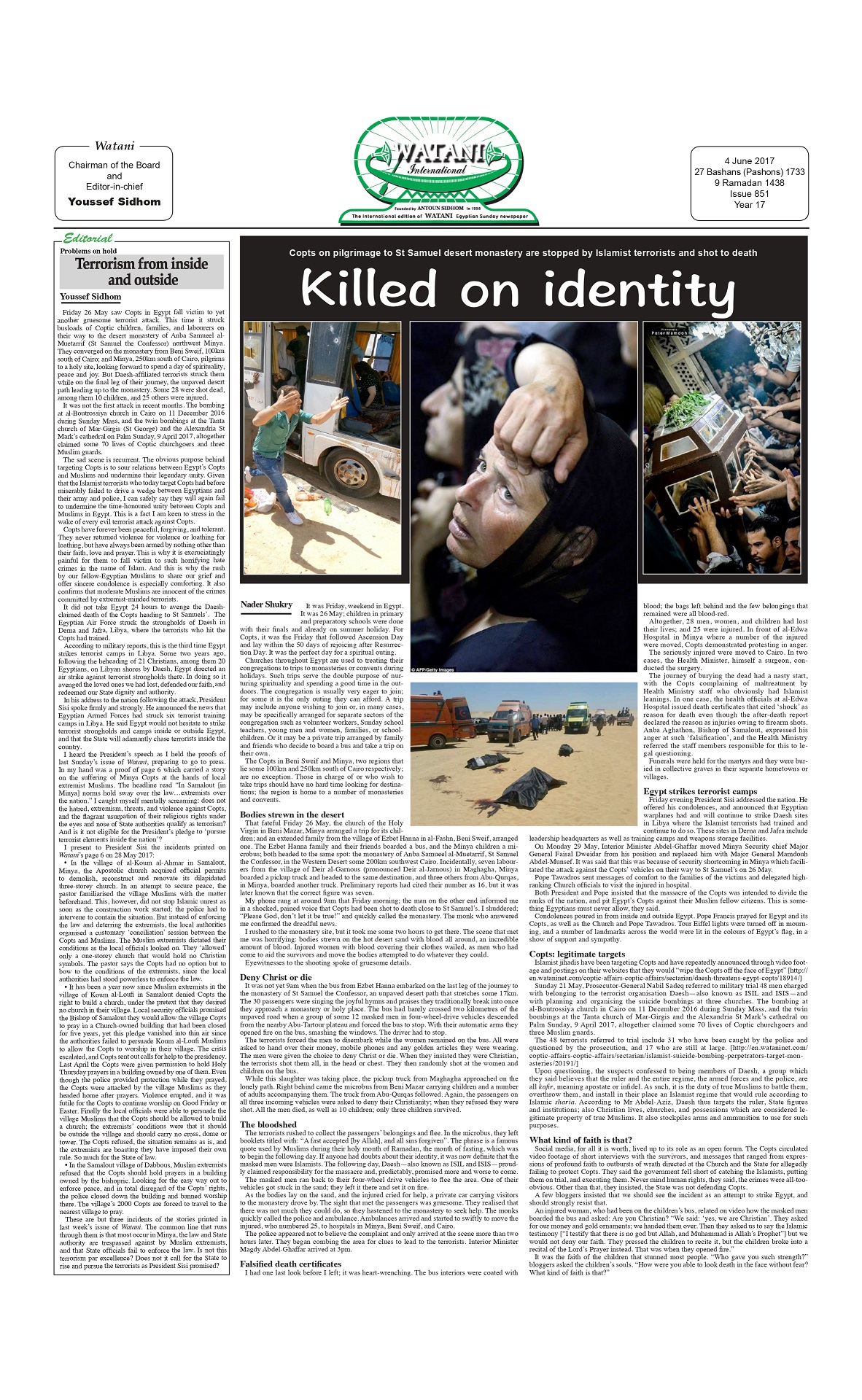
Pope Francis visit
During 2015, 2016, and 2017, Watani International published a plethora of feature stories and interviews.
The paper interviewed Pope Tawadros; Bishop of Youth Anba Moussa; business tycoon Naguib Sawiris; Mama Maggie who is nicknamed Egypt’s Mother Theresa; and Vivian Fouad, head of the Health Ministry’s Programme to Combat Female Genital Mutilation.
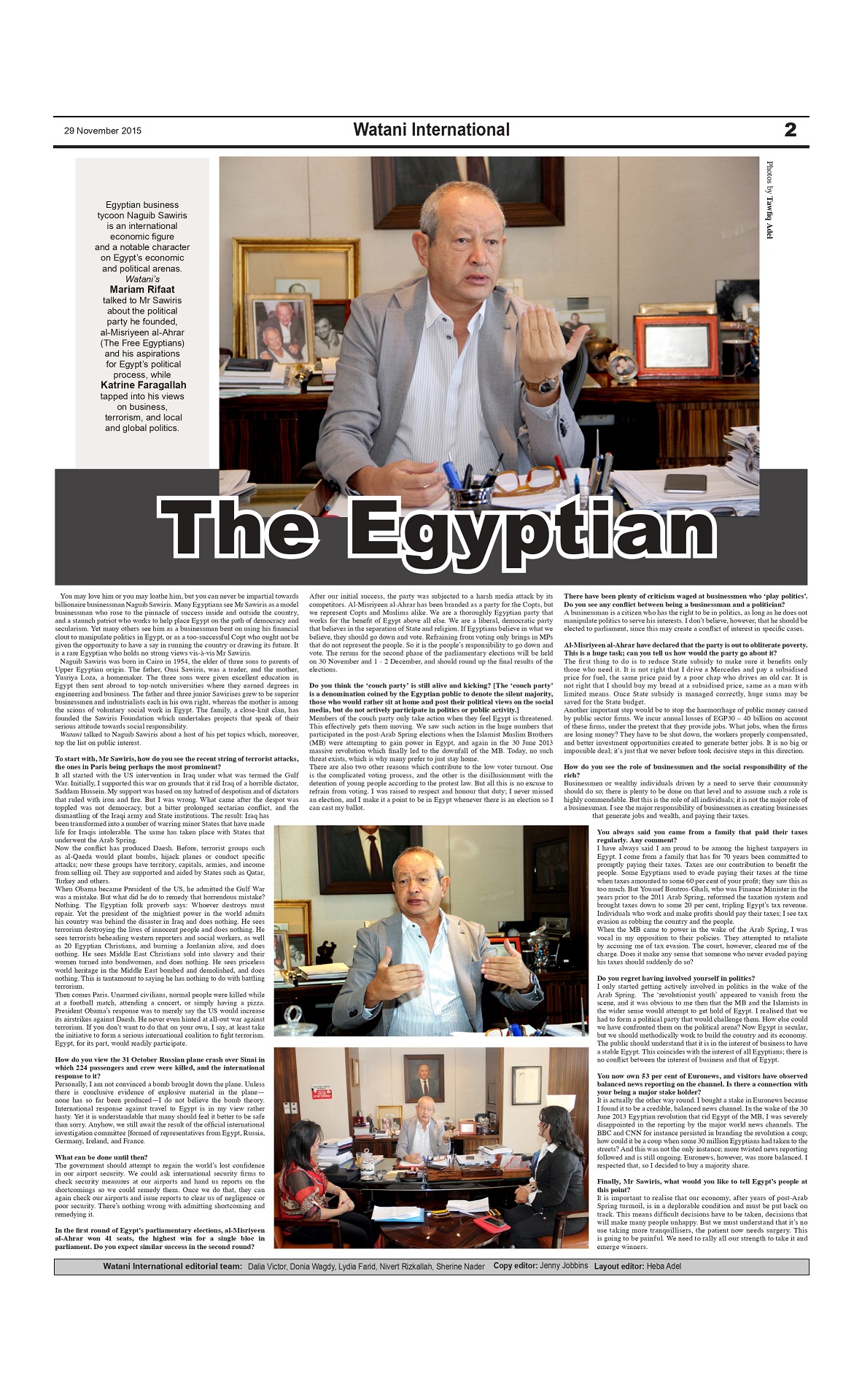
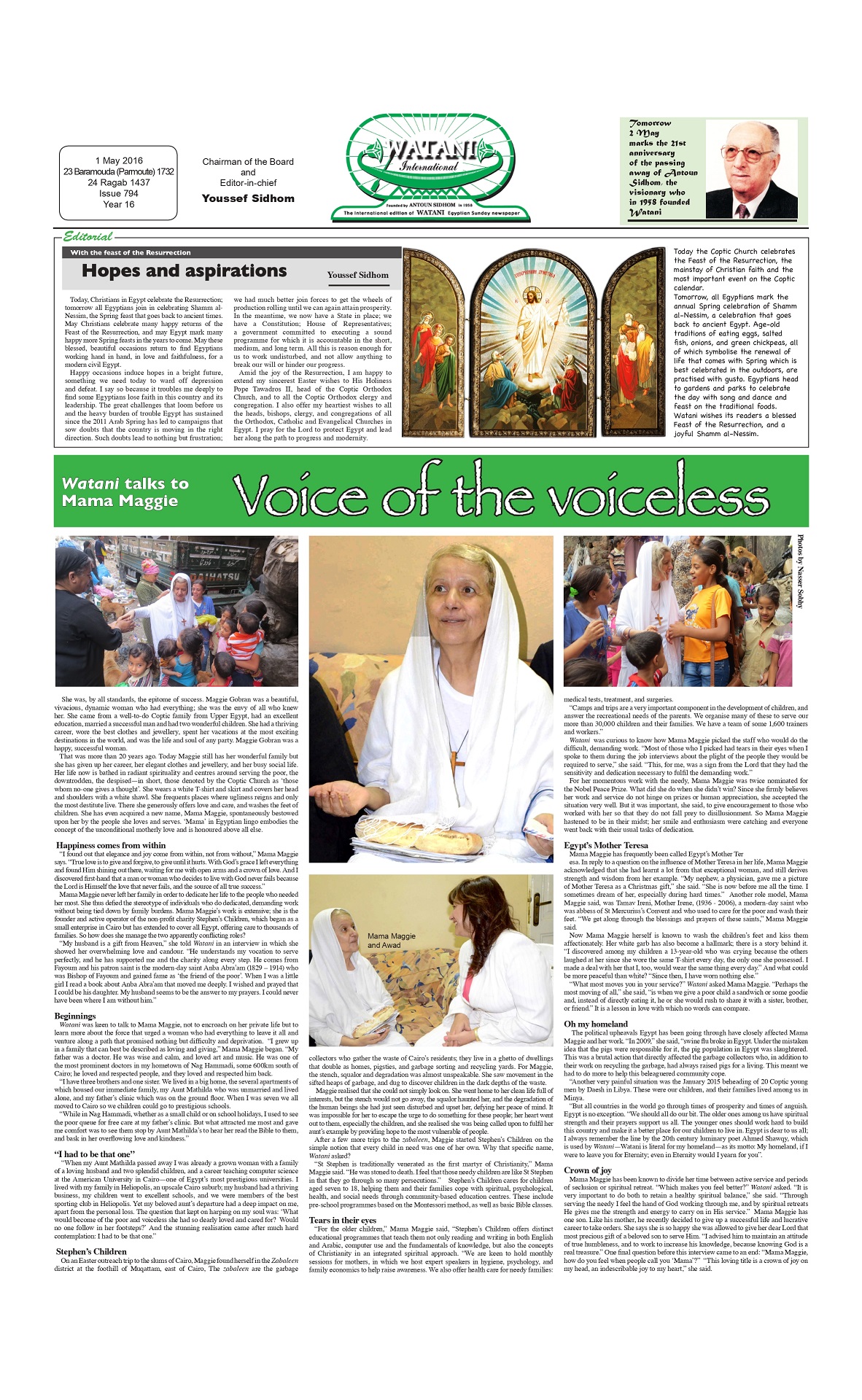
On the Coptic front, our feature stories covered visits by Pope Tawadros to Sohag and Minya where he met and prayed with the families of the Libya Martyrs. Outside Egypt, the Pope paid pastoral visits to The Netherlands, Italy, Austria, Ethiopia, Japan, Australia, Germany, UK, and Russia.
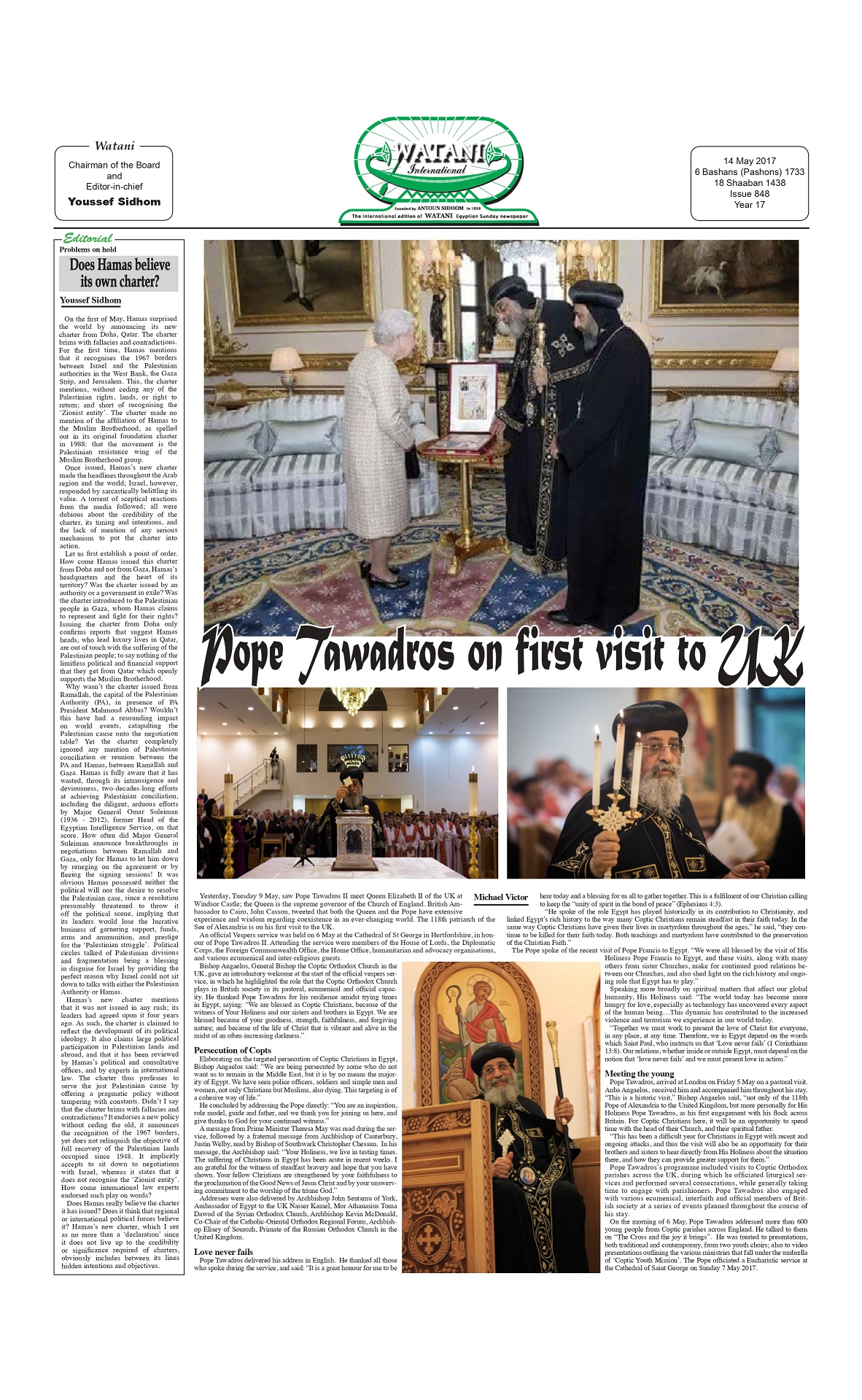
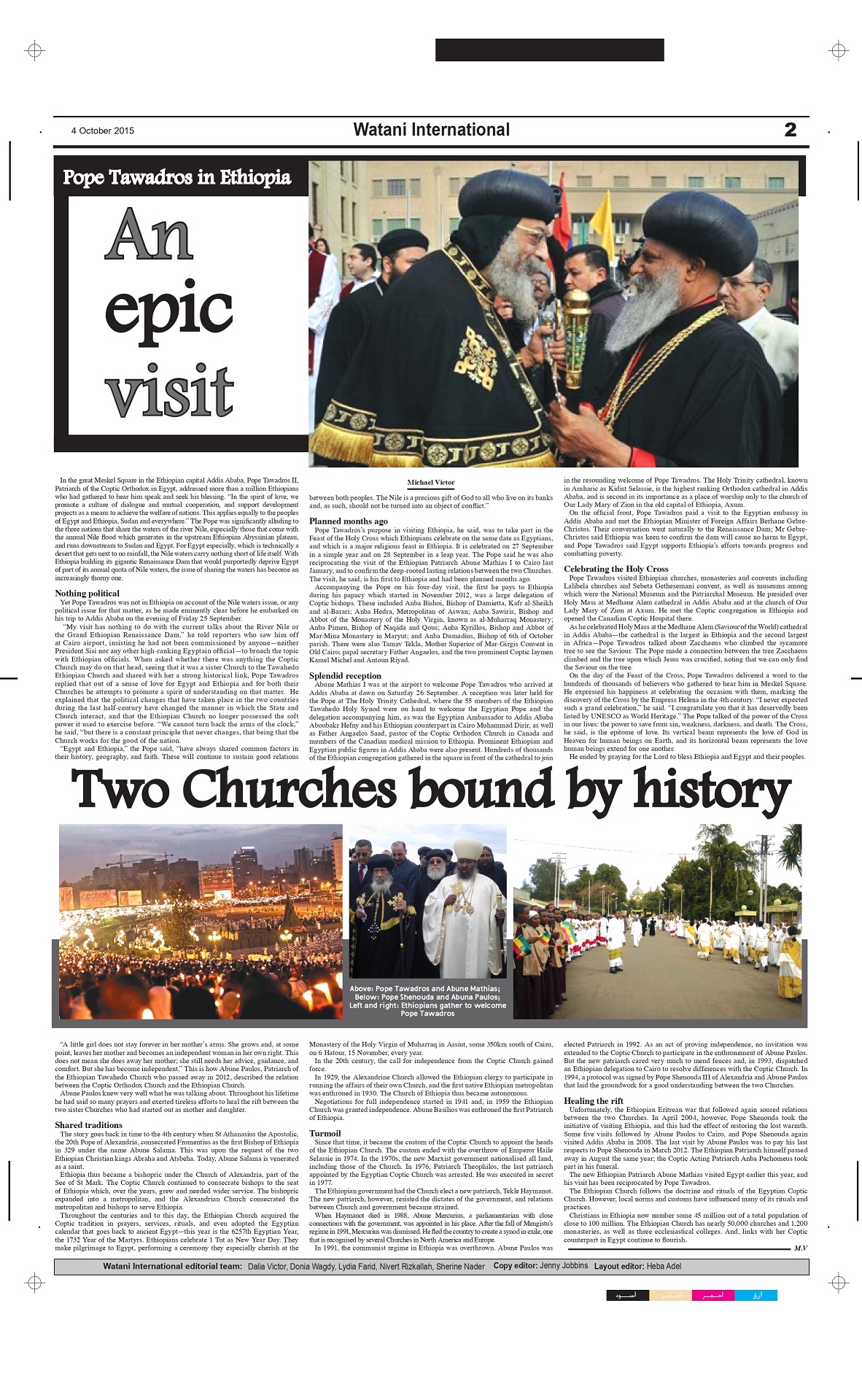
In October 2016, the Coptic Church welcomed Archbishop of Vienna, Cardinal Christof Schonborn, whose activities in Egypt included visits to the families of the Libya martyrs in their village. He later commented that this marked the highlight of his journey.
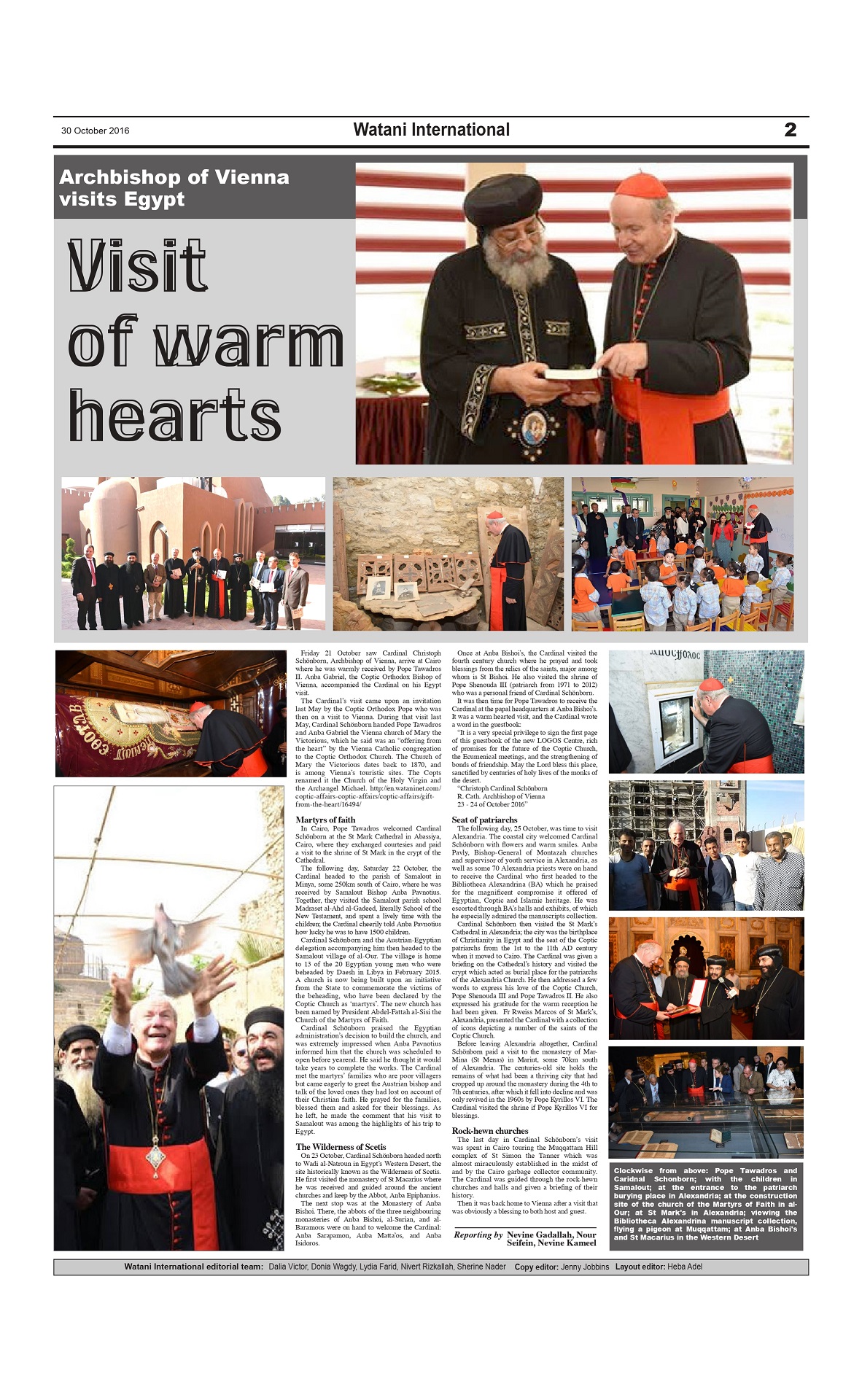
On 28 – 29 April 2017, Pope Francis visited Egypt where he was warmly welcomed by Pope Tawadros; they visited together the shrine of the martyrs at Boutrossiya where they held a commemorative service for modern-day martyrs. Pope Francis participated in a peace conference held by al-Azhar, and celebrated Mass at a stadium in east Cairo.
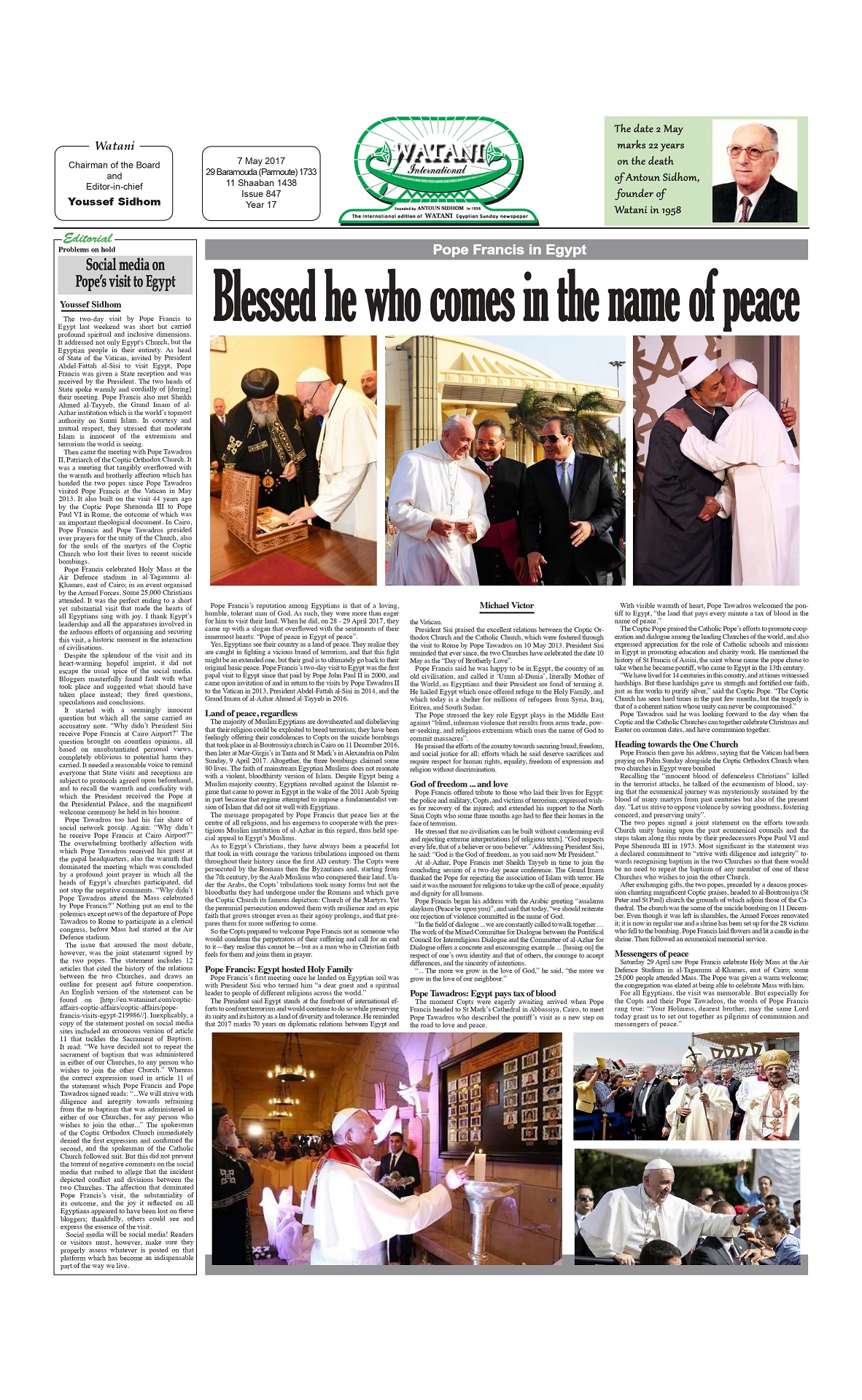
Brilliant features
During the three years under review, our paper published a large number of highly interesting feature stories that included “Weaving prosperity in the countryside” to mark 75 years on the Association of Upper Egypt founded by the Jesiut Fr Ayrout; “The Armenians: Who we are” to mark 100 years on the Armenian genocide at the hands of the Turks; “Antoun Sidhom: Man for all seasons” to celebrate the centenary of Watani’s founder whose life history reads like the history of contemporary Egypt;
“The president who conspired against Egypt” and “The great escape” which both covered the treacherous incidents involving Egypt’s president Muhammad Mursi (1951 – 2019), the Muslim Brother who was then on trial and who had taken office in 2012 – 2013 in the wake of the Arab Spring; “Sustaining life on Lake Bardaweel”; “Dilemma of the Egyptian village”; Flash floods in Wadi Al-Natroun [4th-century] monasteries; “The Bible in our hands” marking 150 years on the most read and most printed Arabic translation of the Holy Bible;
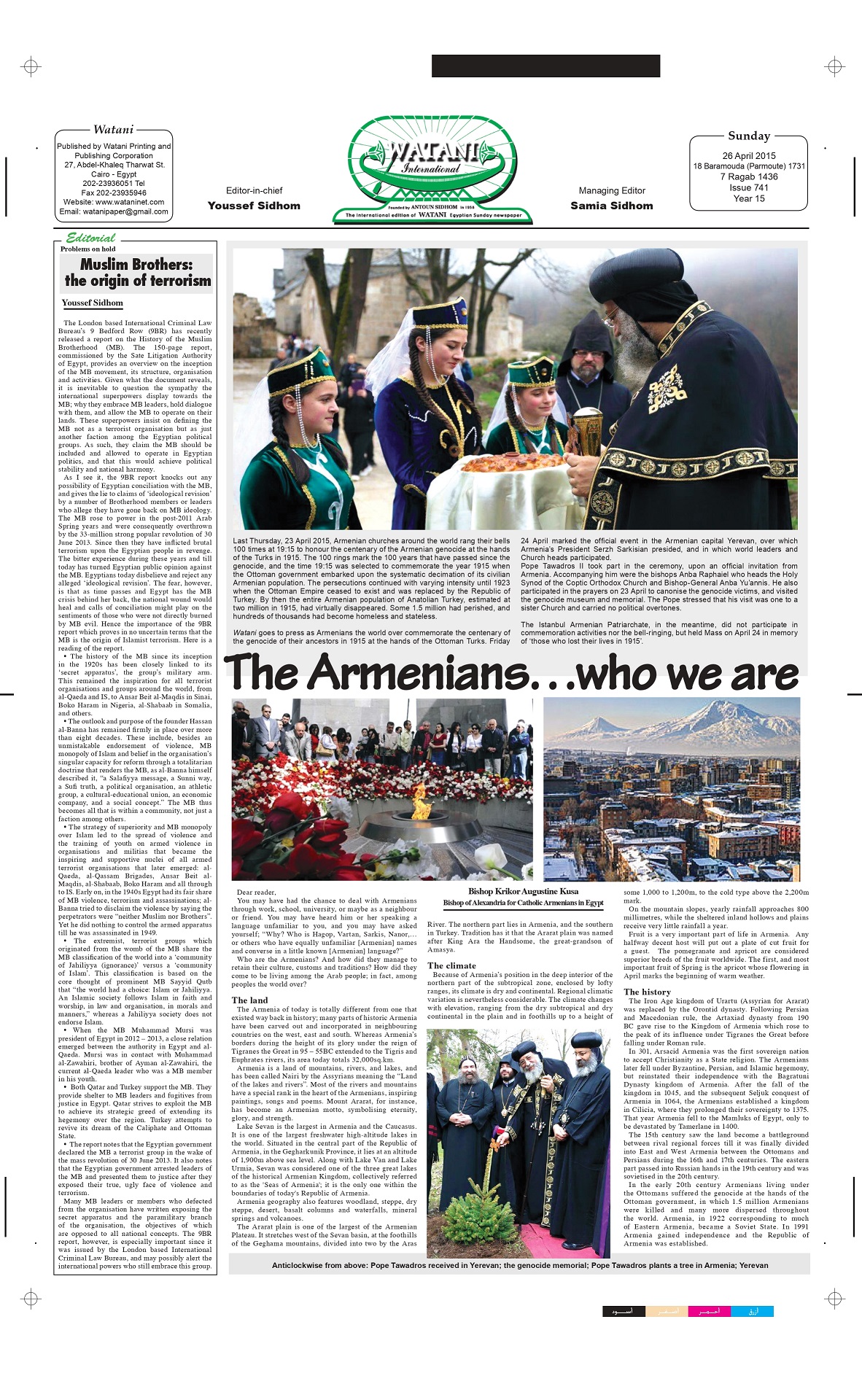
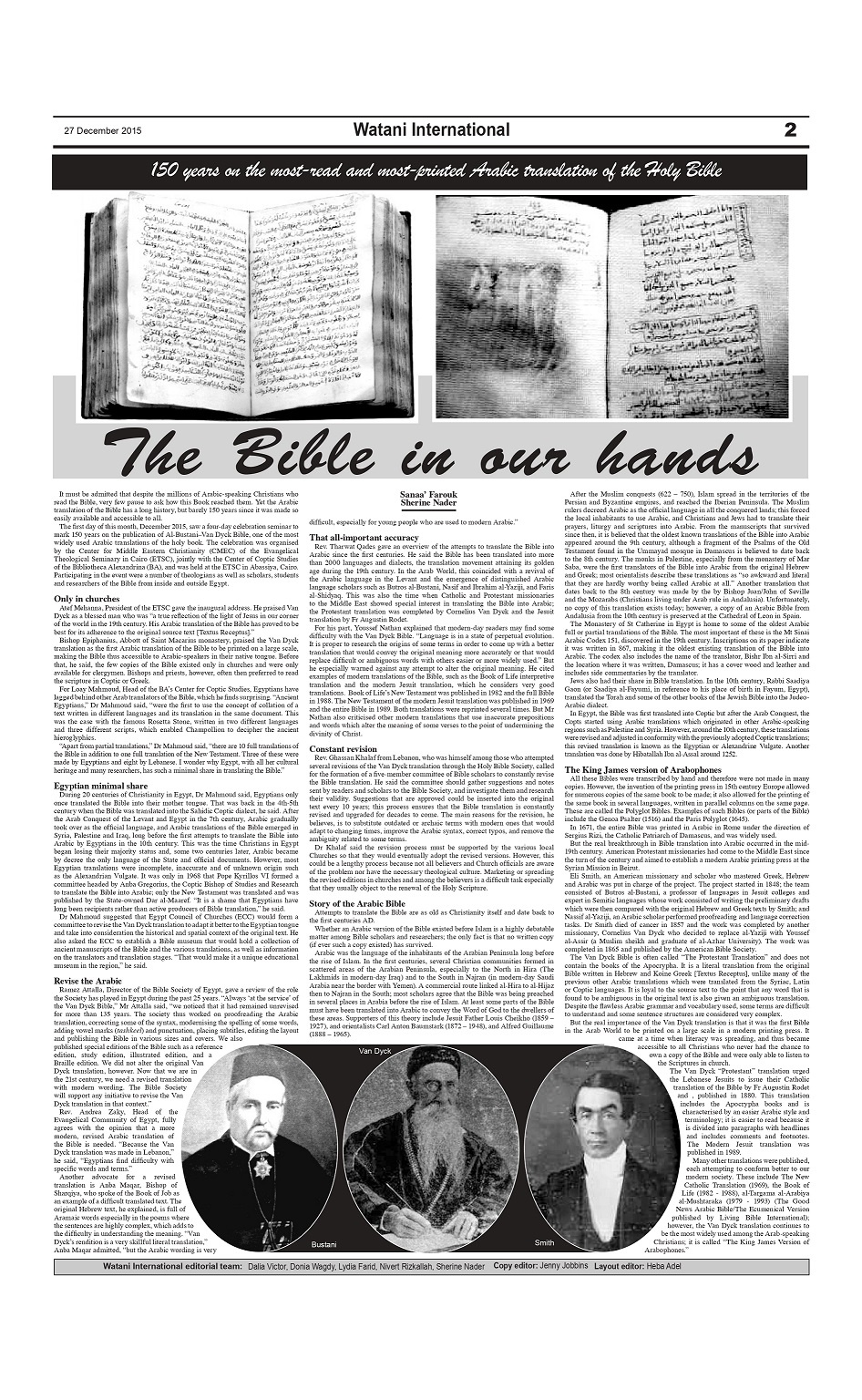
“Illegal migration: a passage to hell” and “Refugees: Hopes and hard times”; “One Nile … one journey” covering the Nile Museum in Aswan; “Coptic art lives on”, a review of Helen Moussa’s guide to the Coptic Museum in Toronto; “An education to relish” on the prospective educational reform which was implemented in 2018; “Risen from the ashes” covering 15 years on the opening of the Bibliotheca Alexandrian; “It’s either us or virus C” on Egypt’s brilliant battle against hepatitis C; “Old houses at new prices?” on the need for a new rental law.
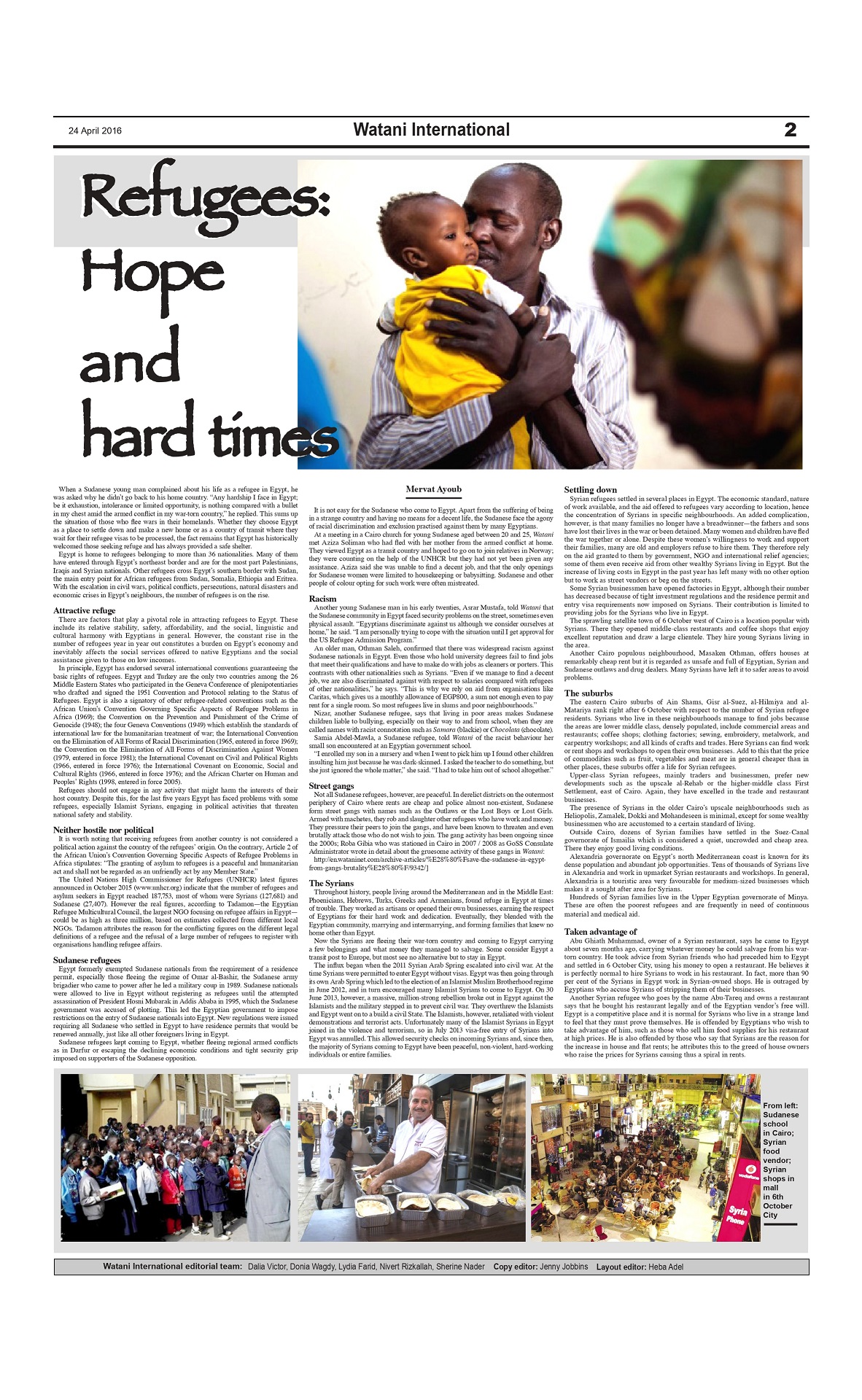
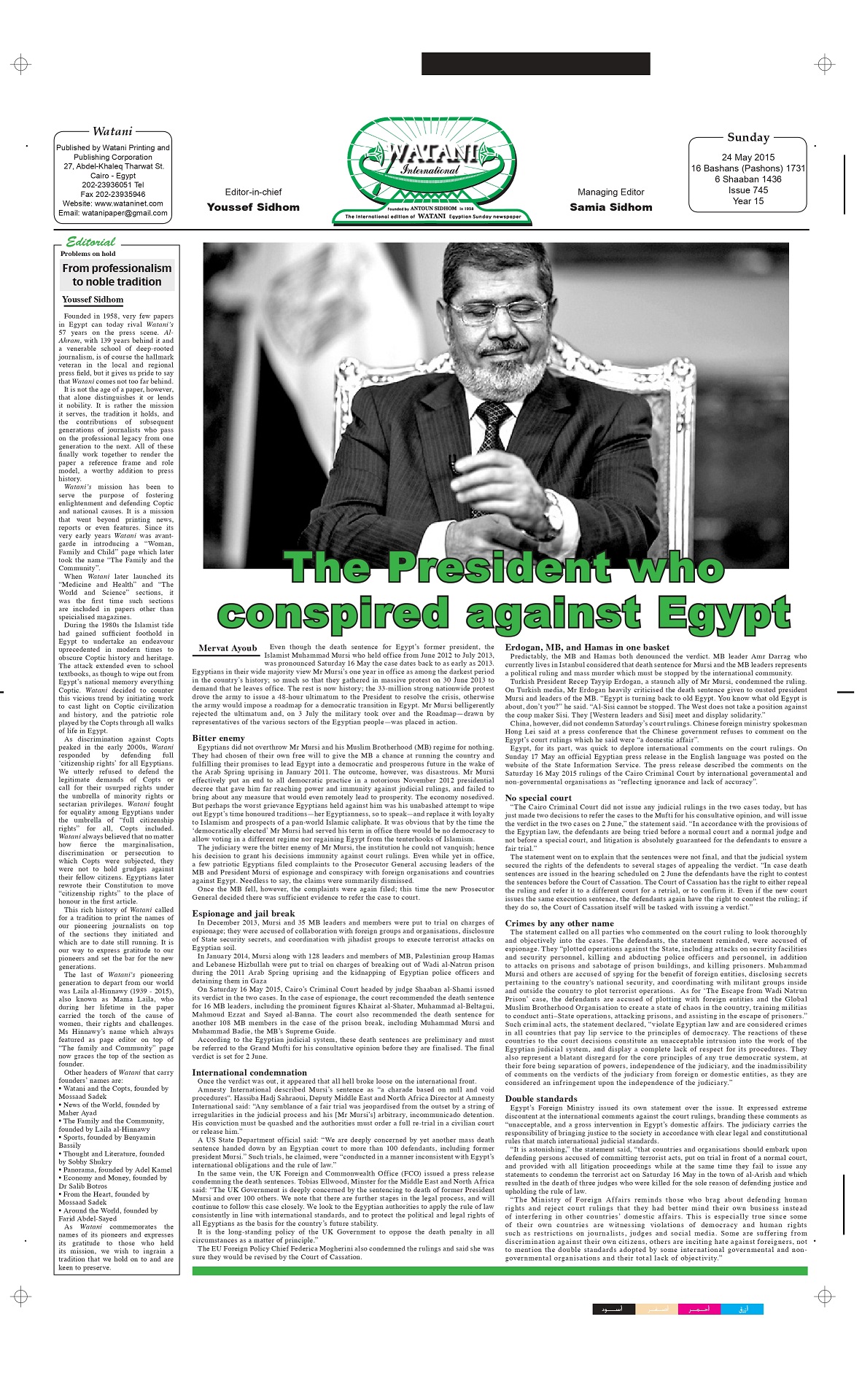
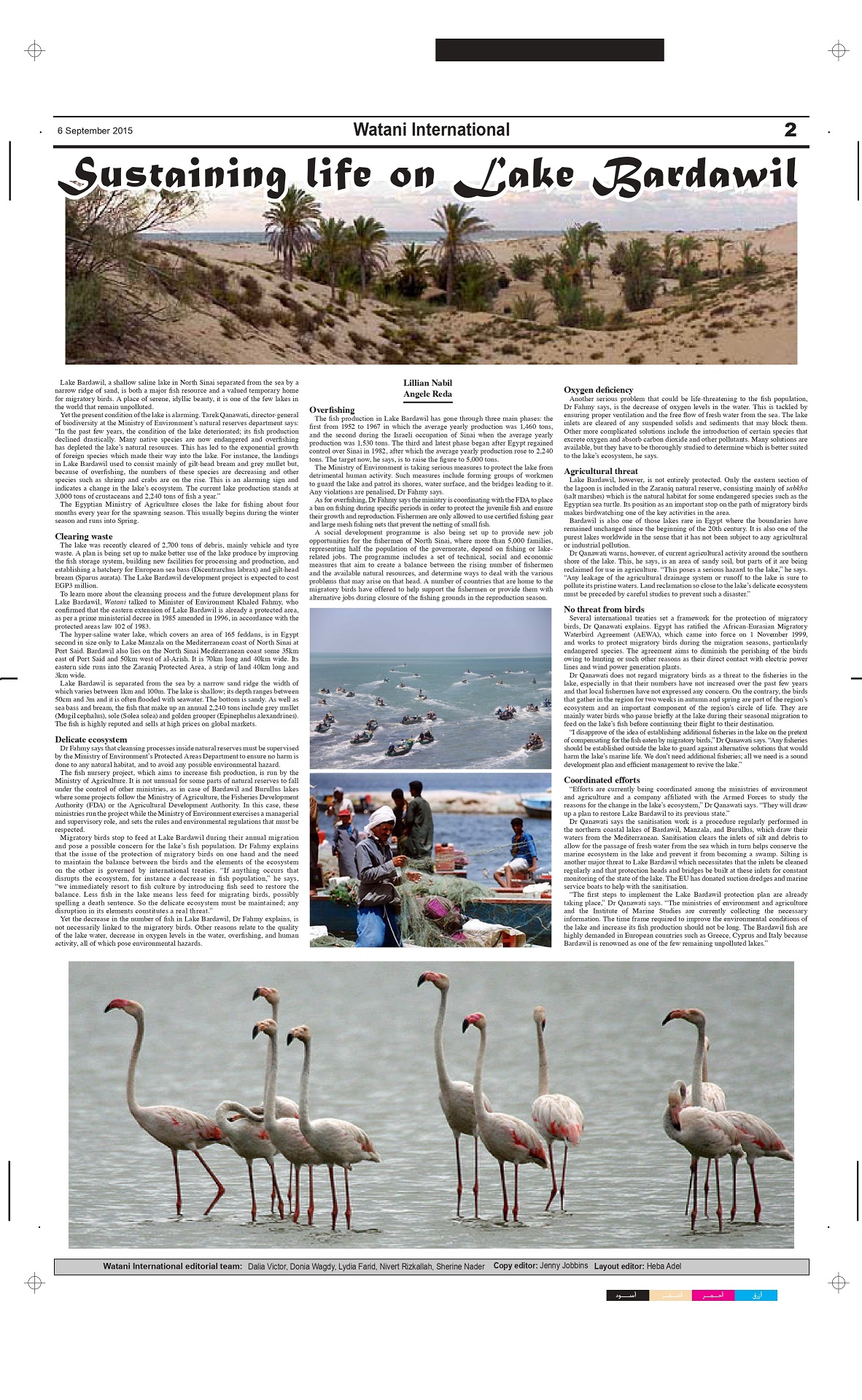
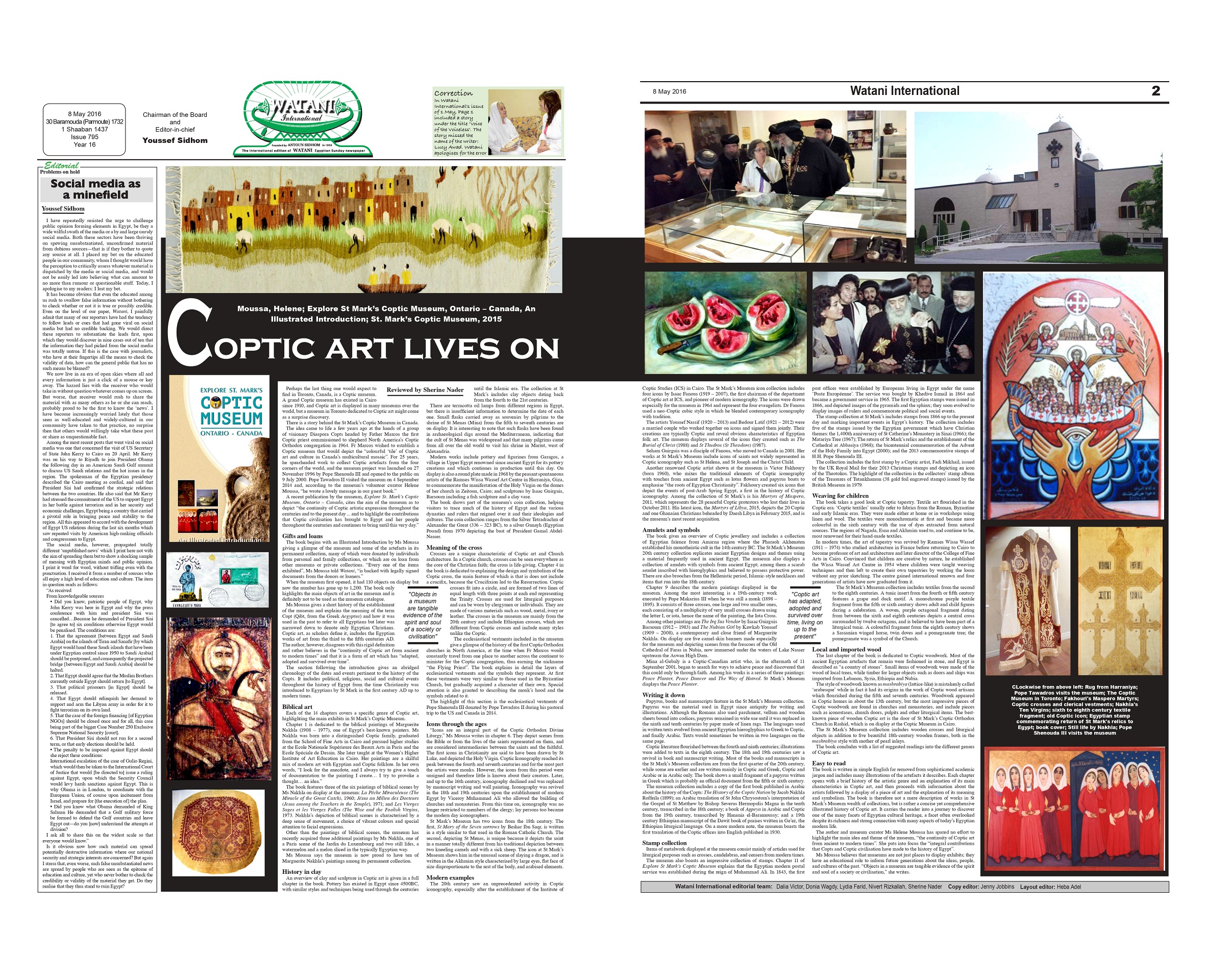
Obituaries
Egypt lost a number of outstanding figures in 2015, 2016, and 2017. Among them were Anba Abra’am, Coptic Archbishop of Jerusalem (1942 – 2015); Anba Sawiris Abbot of Muharraq Monastery (1943 – 2017); Anba Kyrillos of Milan (1965 – 2017); former UN Secretary General Boutros Boutros-Ghali (1922 – 2016);
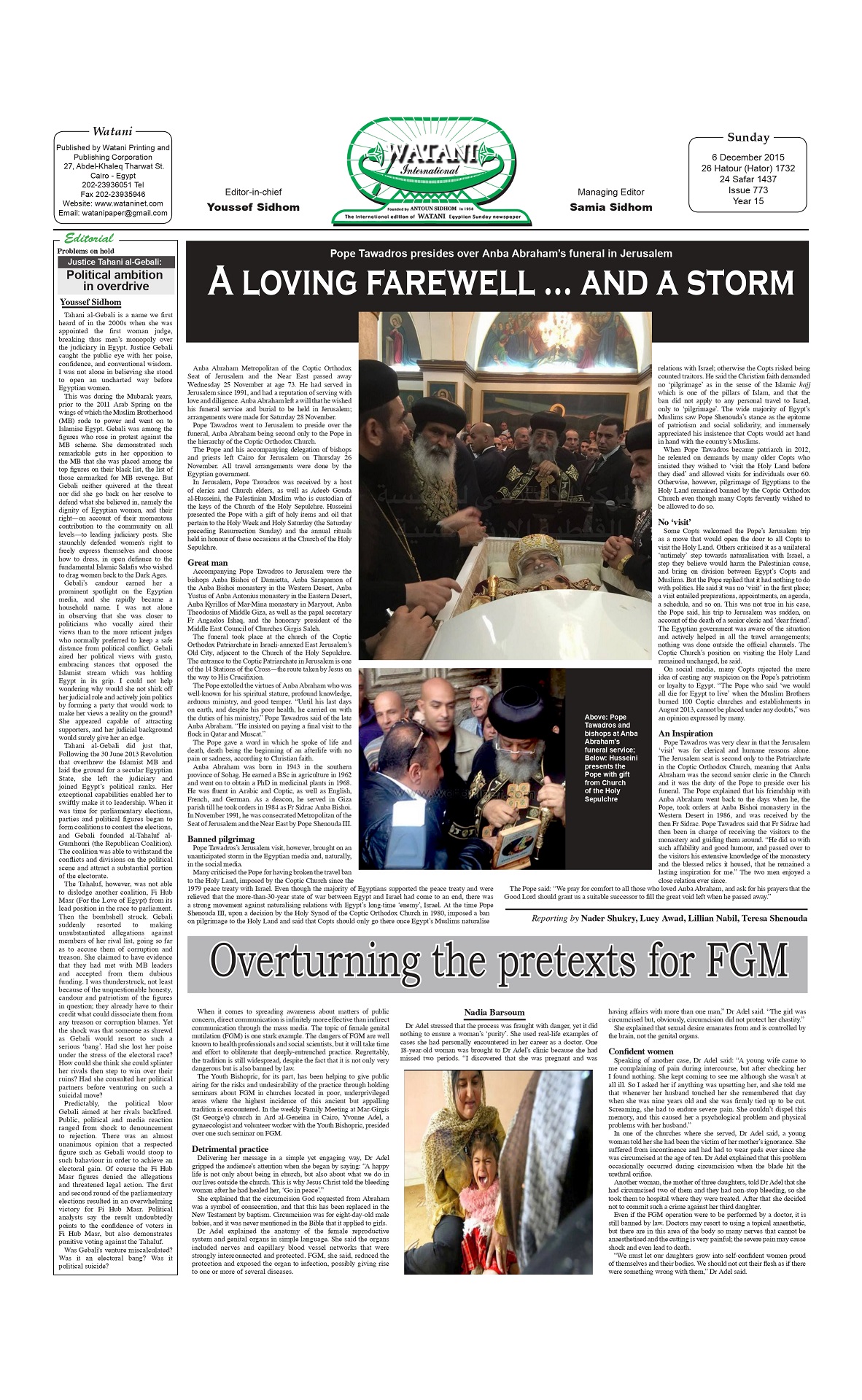
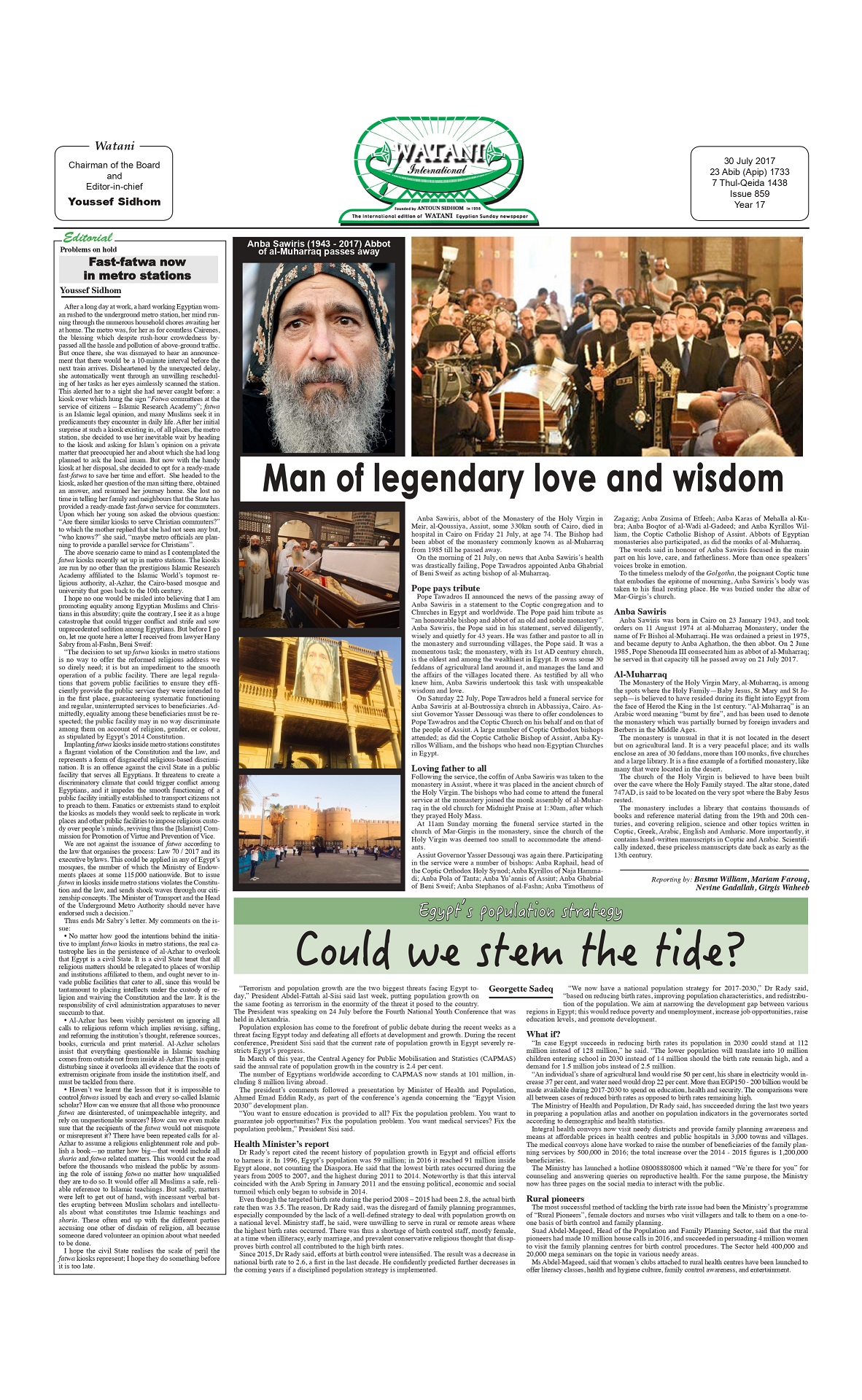
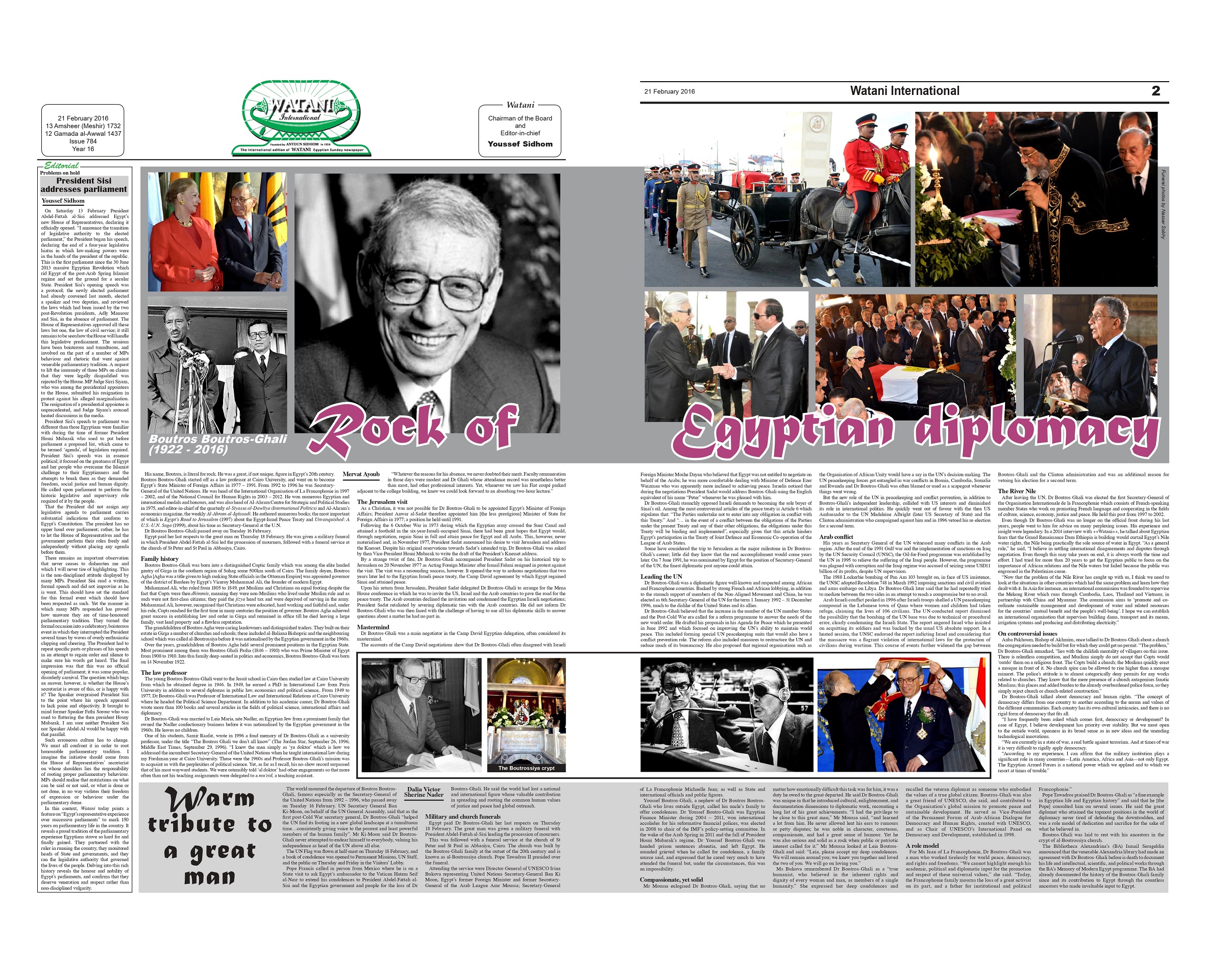
Pioneer journalist Mohamed Hassanein Heikal (1923 – 2016); Ibrahim Abul-Eish (1937 – 2017) who pioneered modern organic agriculture in Egypt; poet Abdel Rahman Al-Abnoudi (1939 – 2015); writer and novelist Gamal al-Ghitany (1945 – 2015); film stars Omar Sharif (1932 – 2015), Faten Hamama (1931 – 2015), Shadia (1934 – 2017), Mahmoud Abdel Aziz (1946 – 2016), and Nour al-Sherif (1946 – 2015); the woman “who saved the Pyramids” Nemat Ahmed Fouad (1926 – 2016); and Watani’s first feminist Laila al-Hinnawy (1939 – 2015).
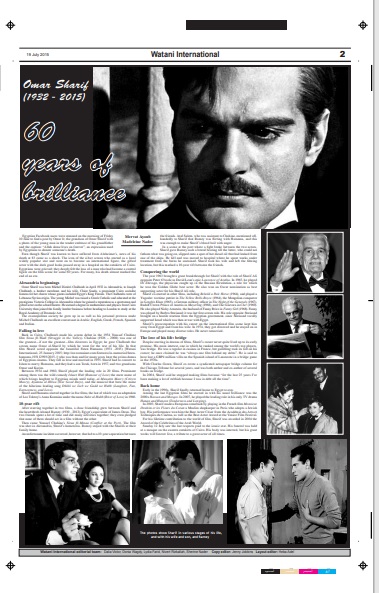
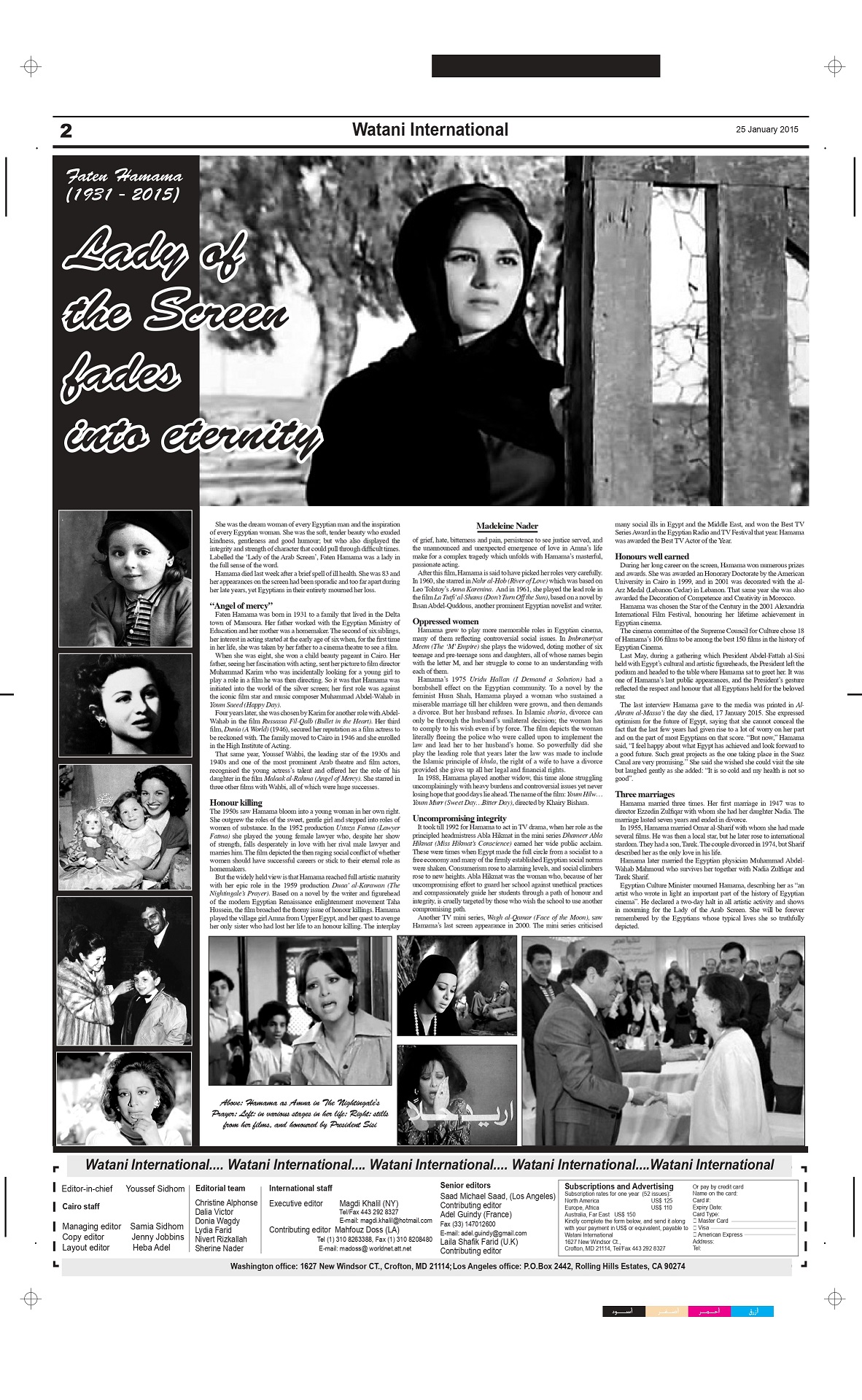
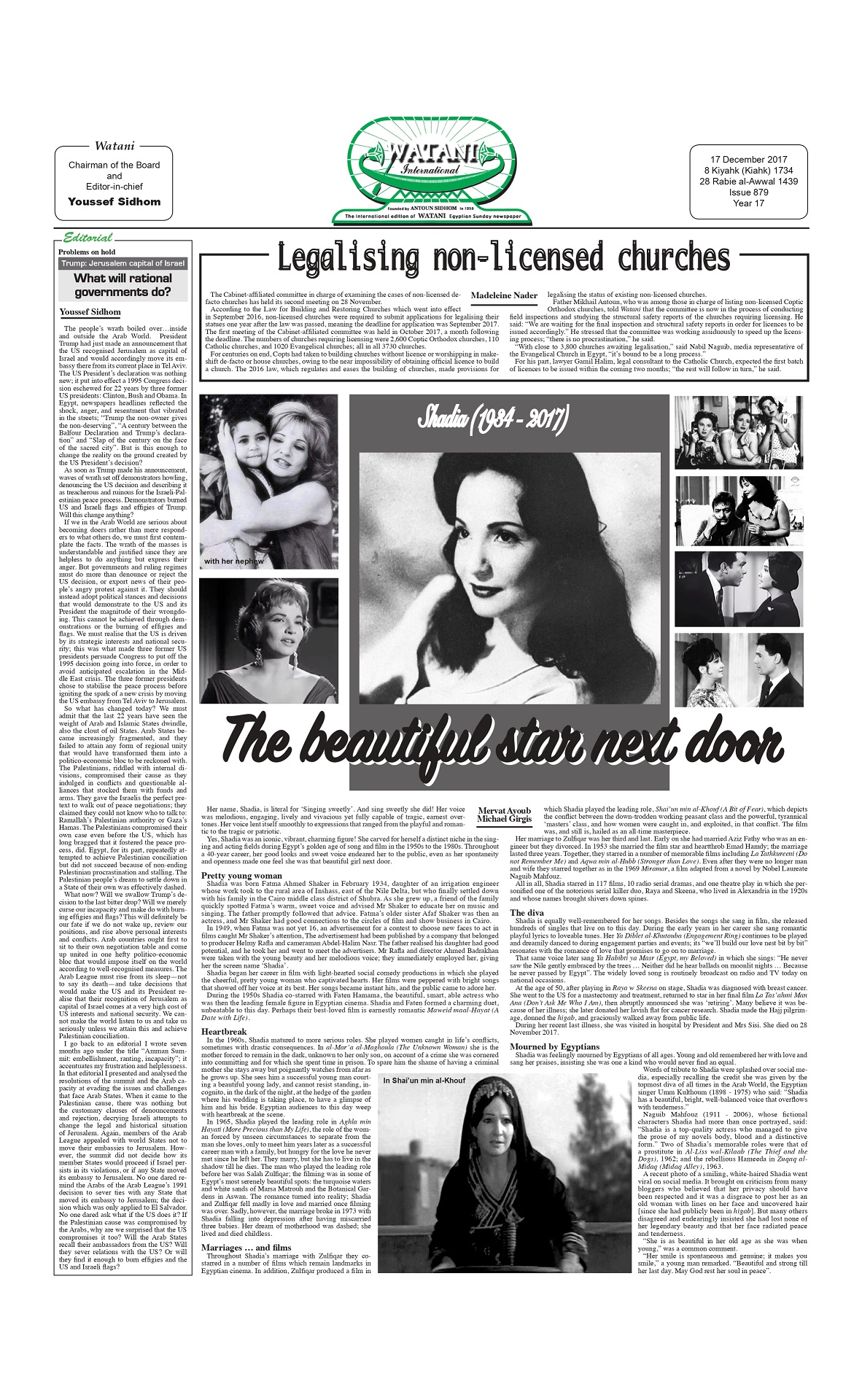
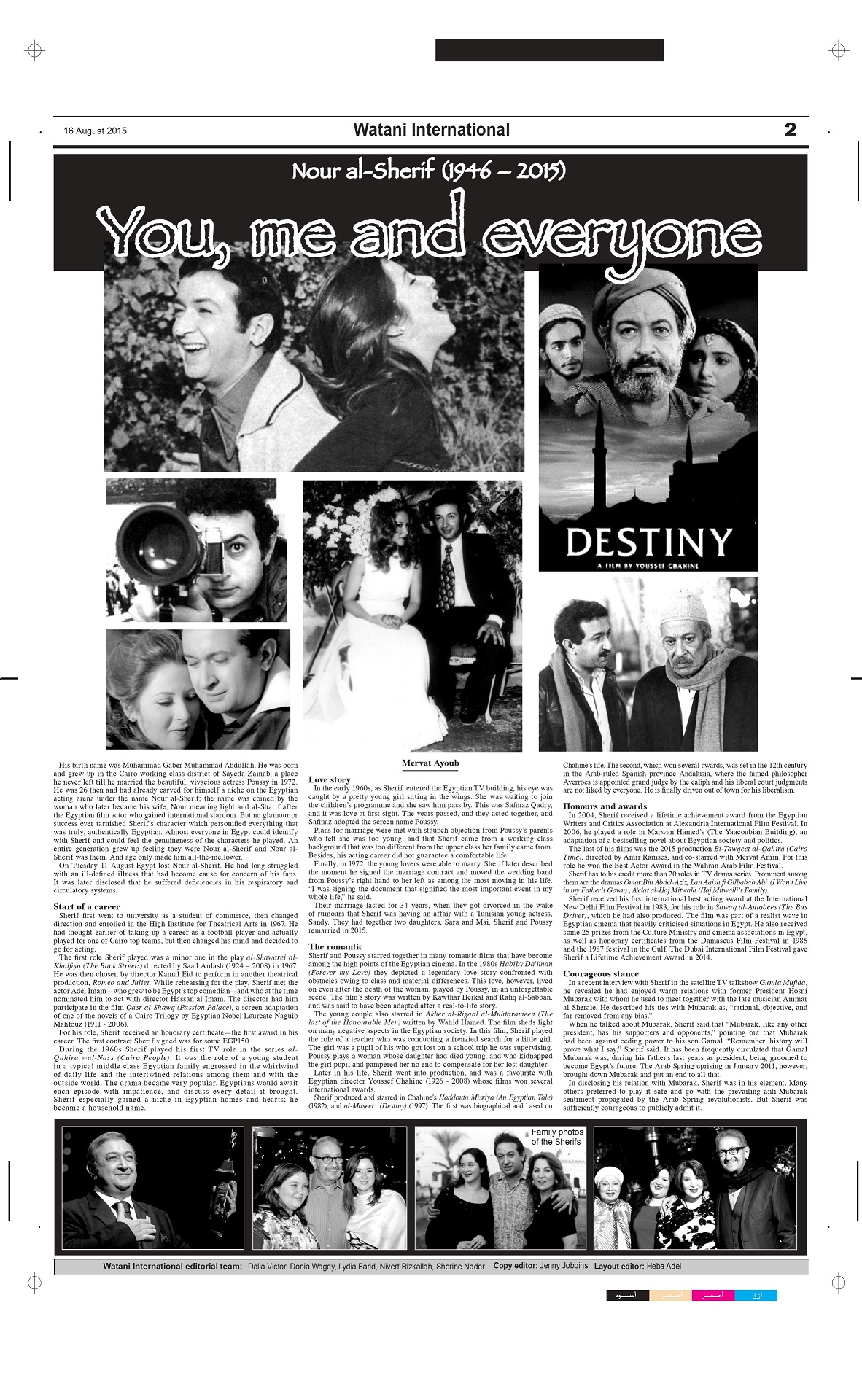
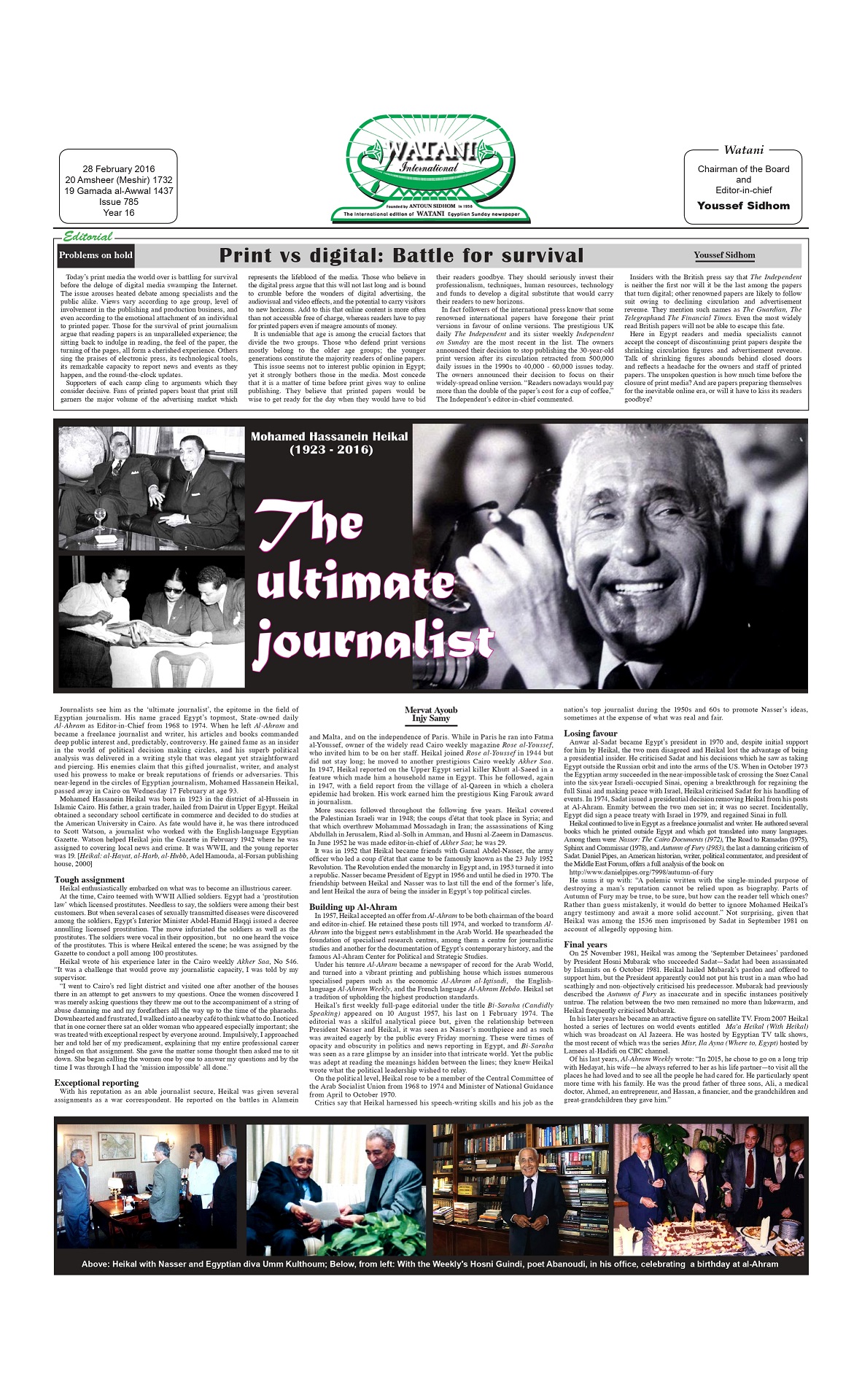
Our journalists covering the content of 2015, 2016, 2017, listed alphabetically:
Amir Abdel-Massih, Sheri Abdel-Massih, Nash’at Abul-Kheir, Islam Abul-Wafa, Mariam Adly, Ekhlass Atallah, Lucy Awad, Amany Ayed, Mervat Ayoub, Marina Barsoum, Nadia Barsoum, Hany Danial, Mennatallah Essam, Amira Ezzat, Katrine Faragallah, Robeir al-Faris, Mariam Farouk, Sanaa’ Farouk, Osama Fayez, Nevine Gadallah, Rehab Gamal, Michael Girgis, Wagdy Habashy, Tereza Hanna, Ashraf Helmy, Rose Hosny, Abeer Ibrahim, Fady Labib, Nevine Kameel, Mary Mansour, Antoun Milad, Hadeer Mossad, Erin Moussa, Lillian Nabil, Madeleine Nader, Sherine Nader, Basma Nasser, Ahmes Labib Pahor, Talaat Radwan, Rimon Al-Rawy, Angele Reda, Magda Rifaat, Mariam Rifaat, Eva Romani, Dahlia Sabek, Georgette Sadeq, Victor Salama, Injy Samy, Soliman Shafiq, Iman Shawqy, Claire Sidqy, Nader Shukry, Samia Sidhom, Nasser Sobhy, Michael Victor, Donia Wagdy, Girgis Waheeb, Basma William
For detailed coverage:
Boutros Boutros-Ghali (1922 – 2016): Rock of Egyptian diplomacy
Mohamed Hassanein Heikal (1923 – 2016): The ultimate journalist
Faten Hamama (1931 – 2015): Lady of the Screen fades into eternity
Pope Tawadros in Australia: “Seed sown 50 years ago bears abundant friut”
Watani International
10 April 2022










